Flip Chart
Use the 2-sided presentation tool to walk your patients through LSS, their treatment options, and what to expect with the mild® Procedure.
In the evolving landscape of medical care, collaboration between different specialties is proving to be a game-changer for patients dealing with complex conditions. One such collaborative effort that stands out is the partnership between interventional pain physicians and spine surgeons in managing lumbar spinal stenosis (LSS). This contemporary approach aims to provide patients with a continuum of care that merges the expertise of both fields, resulting in better outcomes and improved patient experiences.
Historically, the divide between pain management and surgical intervention was palpable. However, this narrative is rapidly changing, as exemplified by the journey of Dr. Stevenson, a veteran neurosurgeon, and Dr. Antony, an interventional pain physician. Their collaboration, cautious at first, quickly evolved into a transformative model of patient care.
The key to this success lies in breaking down perceived barriers. Both specialists found that open communication, transparency, and a shared goal of patient well-being were the bridges that brought them together. Instead of focusing on the contrast between their specialties, they recognized the value of mutual learning. This synergy allowed for comprehensive discussions surrounding spinal stenosis treatment options. Topics of open discussion included MRI interpretations, indications for different procedures, and when surgery should be considered as an early option. It was a shift from a mindset of “last resort” to “best-suited solution.”
One of the most remarkable aspects of this collaboration was the way it empowered advanced practice providers (APPs), such as physician assistants (PAs), to become integral members of the patient care team. Armed with the ability to read imaging, understand evidence-based outcomes, and confidently make clinical decisions, APPs played a crucial role in identifying suitable patients for various treatments. This streamlined approach enabled faster diagnoses, quicker referrals, and ultimately, better patient experiences.
An excellent example of this collaboration in action was the mild® Procedure, a minimally invasive technique for treating lumbar spinal stenosis. This procedure served as a catalyst for discussions that led to deeper understanding and synergy between pain management and surgical interventions. With shared imaging interpretation and a clear algorithmic approach, the team was able to offer patients tailored solutions that ranged from minimally invasive interventions to spinal stenosis surgery, depending on the individual case.
The success of this collaborative approach was reflected not only in patient outcomes but also in practice growth. The combined efforts of pain management and surgical teams resulted in an increased patient volume, dispelling the notion that collaboration might hinder individual specialties. Instead, it enhanced the quality of care across the board.
The success story of Dr. Stevenson, Dr. Antony, and their team serves as an example for all medical professionals seeking to bridge the gap between specialties. The barriers that once stood between pain management and surgical intervention are now seen for what they truly are—perceived limitations that can be dismantled through open dialogue, shared expertise, and a genuine commitment to patient well-being. Through collaborative efforts, the medical community can continue to optimize patient care and shape a brighter future for all.
To hear more about this collaboration in action, from Drs. Antony and Stevenson themselves, please click the link below to listen to “The Pain Physician & Spine Surgeon Relationship” on ASPN’s Pain Unfiltered podcast.
Listen to the Full Podcast Here About Dr. Ajay Antony
About Dr. Ajay Antony
Dr. Ajay Antony is an interventional pain physician, working at The Orthopedic Institute after 4 years as a faculty member at the University of Florida (UF). He earned his bachelor of science at the University of Florida and earned his medical degree at St. George University School of Medicine. He went on to complete his anesthesiology residency and pain medicine fellowship training at UF. After joining the faculty, Dr. Antony served to: grow the fellowship program to national recognition, bring several new procedures to the Florida community, and continue to be a recognized leader in his specialty. Dr. Antony is a member of many professional academic societies such as the Alpha Omega Alpha Honor Medical Society, the North American Neuromodulation Society (NANS), and the International Neuromodulation Society (INS). He has lectured both nationally and internationally and teaches national training courses for fellows and practicing physicians.

About Dr. John Stevenson
Dr. John Stevenson is a board-certified neurosurgeon who specializes in spine surgery, working at The Orthopedic Institute. Dr. Stevenson became a neurosurgeon because of his love for neuroscience and the influence of his father. He received his undergraduate education at Oberlin College and his medical training at the University of Glasgow. He then went on to complete his residency training in neurosurgery at Duke University Medical Center. Dr. Stevenson is a member of numerous professional associations, some of which include The American Association of Neurological Surgeons, Fellow of the Royal College of Surgeons of England, and the Congress of Neurological Surgeons.
Interventional Pain Management is a fast-growing specialty. As new lumbar spinal stenosis (LSS) procedures become available, practices are evolving the way they collaborate and work together to optimize patient care. The mild® Procedure’s patient selection process is quite simple, but requires imaging review, which is often not a part of Advanced Practice Providers’ (APP) traditional education.
The Vertos APP Advisory Board has emphasized the need for educational tools for APPs who would like to develop their image review skillset. Two of the esteemed Vertos APP Board Members, James Lynch, PA and Kelsey Kimball, PA, partnered with their physicians Dr. Michael Verdolin and Dr. Ajay Antony to provide an interactive workshop focused on enhancing imaging review skillsets. View the interactive workshop where they cover imaging basics, navigating software, measuring the ligament, and more!
Looking for more info on mild® patient identification criteria? Check out our blog: Identifying & Educating mild® Patients – APP Guidance.
Also, be sure to connect with us to stay informed of upcoming APP-specific educational and peer engagement opportunities. Sign up and receive the latest updates!
Sign Up Nowmild® is often referred to as a “simple little procedure” that can make a major impact on the quality of life and mobility for lumbar spinal stenosis (LSS) patients. Minimally invasive lumbar decompression (mild®) removes the problem and leaves nothing behind—no implants, no stitches—allowing patients to stand longer and walk farther with less pain. A short, outpatient procedure, it is performed through a single 5.1mm incision in the patient’s lower back, addressing a major root cause of lumbar spinal stenosis by removing excess ligament tissue. Patients typically resume normal activity within 24 hours with no restrictions.
So, how do practices describe this “simple little procedure” to their patients? We like to say the mild® Procedure is similar to “removing a kink in a drinking straw,” reducing the compression on the nerves in the lower back to restore mobility and relieve pain.
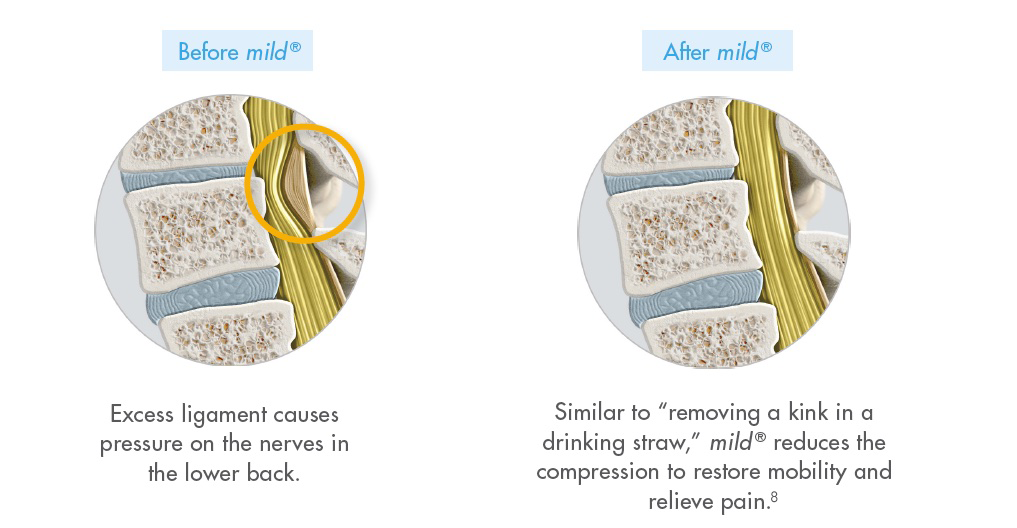
We asked a group of mild® physicians how they describe the mild® Procedure and its big, life-changing potential to their patients and referring physicians. We heard a lot of fun analogies—here are a few of our favorites.
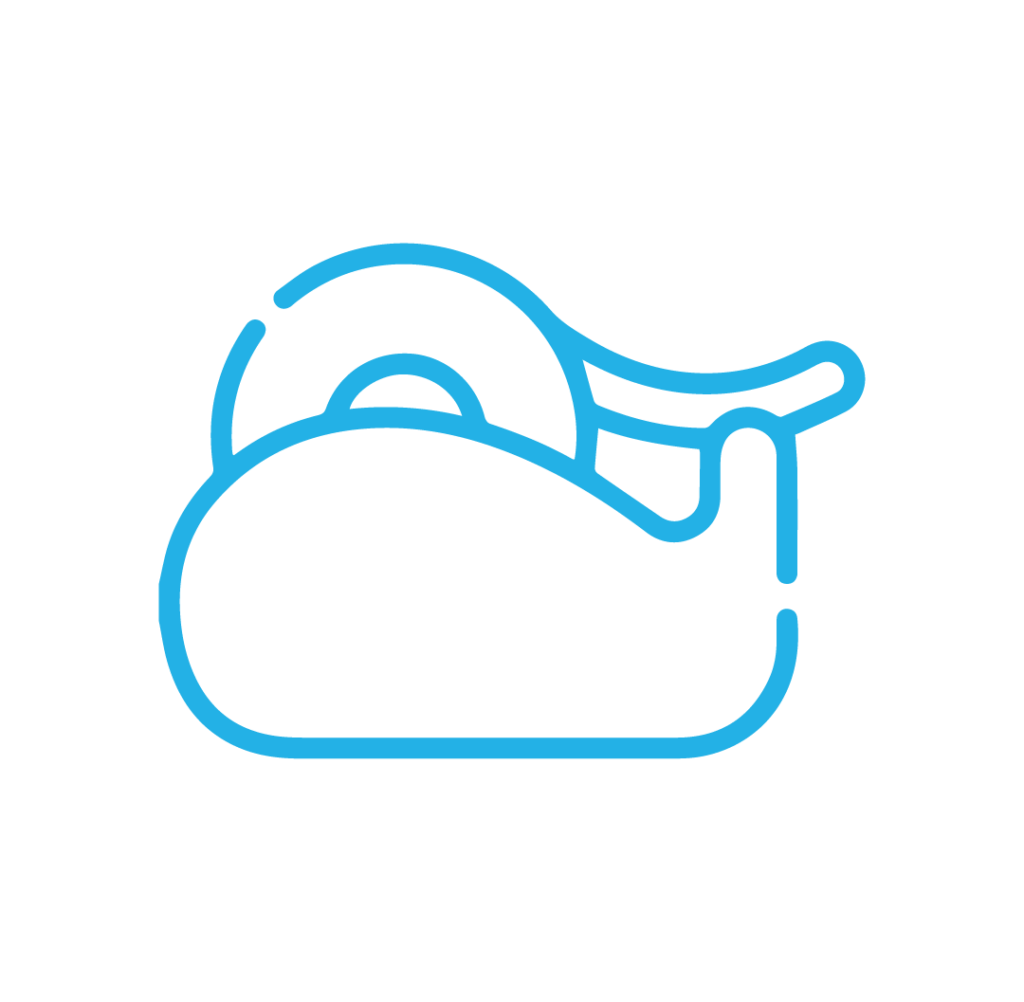

I describe mild® to my patients as a “quality-of-life procedure.”
I walk them through my algorithm and I say, “Listen: I can put a temporary Band-Aid [solution] on this for you with an epidural steroid injection (ESI), or I have a tool in my toolkit that could hopefully fix this for you where it’s not just a Band-Aid. It really improves your quality of life.”
Once you frame it this way for patients—as an epidural being a Band-Aid, with mild® being more of a definitive procedure—you have a captive audience that typically wants to go ahead and get a percutaneous decompression.


Our patients are generally familiar with cardiology procedures. So, I tell them lumbar spinal stenosis treatment options are similar to the options available for patients with coronary artery stenosis. You can either treat them with meds to improve blood flow or put in a stent to open it up more permanently. The mild® Procedure restores space around the spinal cord, just like a stent restores space in your blood vessels.
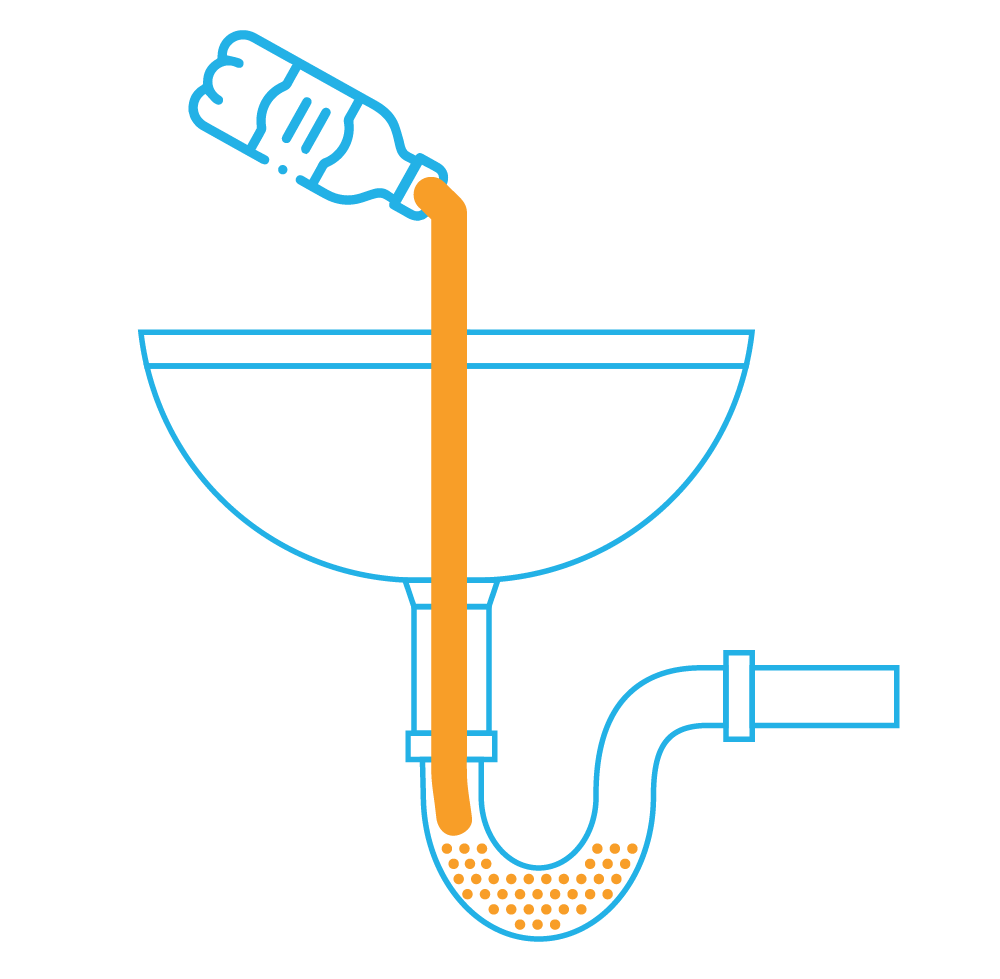
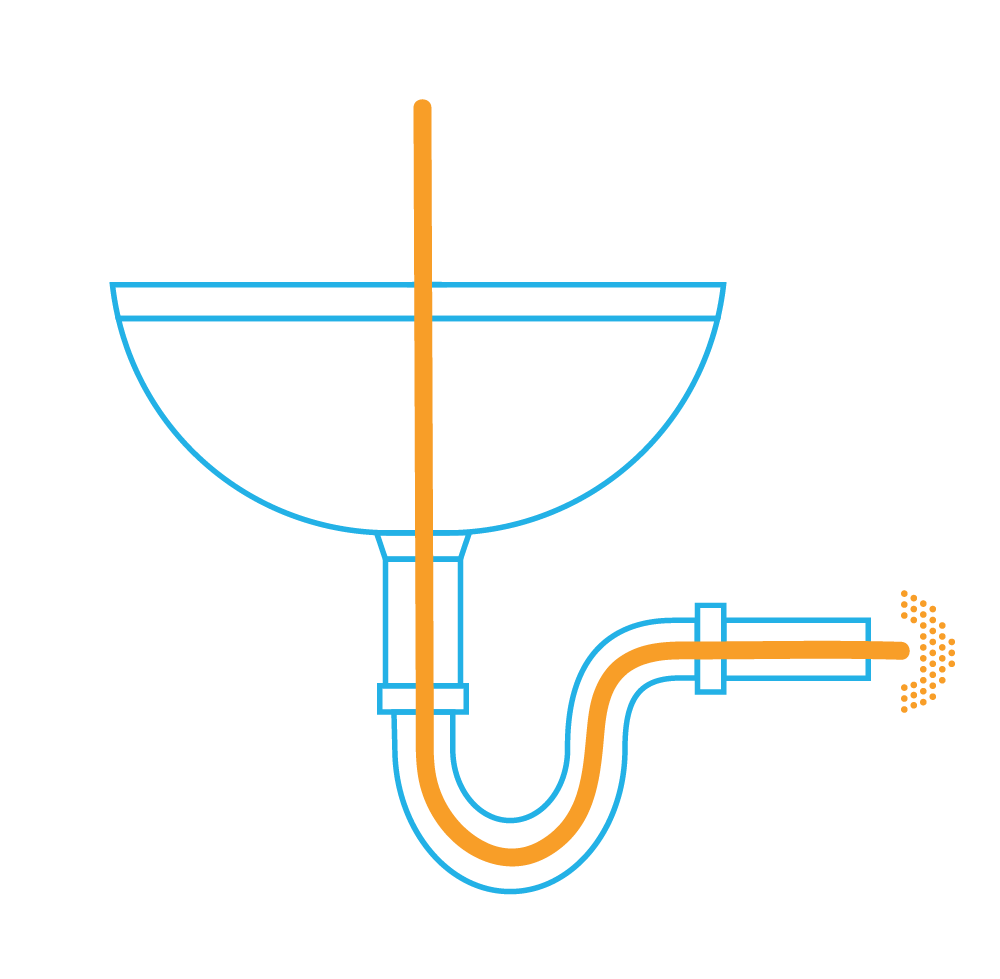
I tell patients: “Your spinal canal is kind of like your sink when it gets clogged. If your sink is really clogged, you can pour Drano down it all you want. But that’s a temporary fix, and it doesn’t work long-term. At some point, you’ve got to get in and unclog the drain.”


I describe how mild® works like fixing a room that is overcrowded with furniture. I tell them:
“Imagine a room full of tables and chairs, and you just can’t move around. What I am going to do today is just take a couple of chairs out to make some more space, so your anatomical structures can move around easily.”

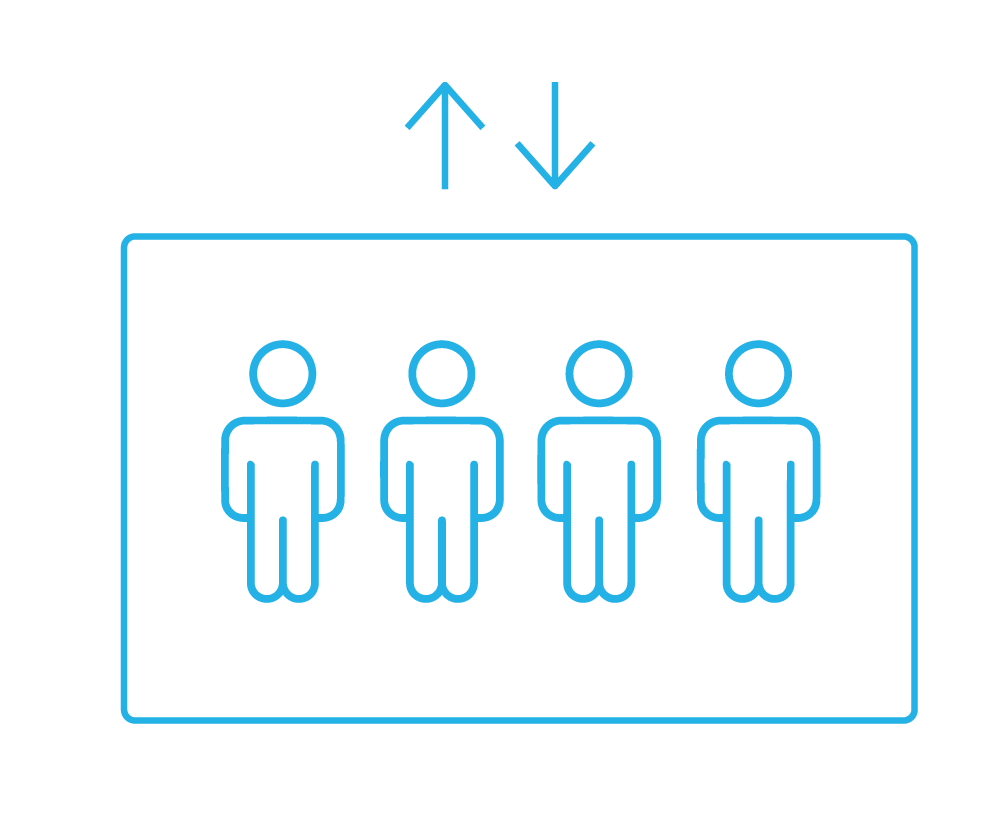
“When I describe what stenosis/LSS does to a patient’s spinal canal, I compare it to having too many people in an elevator. What we do with mild® is open the door and let a few people out so that the folks remaining have more room to move freely for the ride.”
How do you describe mild® to your patients? If you have an effective analogy you use to talk about the benefits of mild® or its approach, we’d love to hear about it. Email us today. If you need additional patient resources, please contact your Vertos representative.
As a mild® provider, it’s important to brand yourself as a mild® practice to attract new patients and educate people in your community who are searching for relief from lower back pain and mobility issues. By presenting the mild® Procedure as part of your treatment offerings, you can highlight that your practice provides advanced lumbar spinal stenosis (LSS) treatment options for potential patients searching for alternative solutions to epidural steroid injections (ESIs), pain medication, or back surgery.
The following patient education, healthcare professional, and digital (web/social) resources will help ensure your practice is well-equipped in identifying and educating the community and your referral networks about LSS, and how mild® can play an effective role in a patient’s care path.
Outfit your practice so patients know you offer the mild® Procedure.
Add information about mild® to your website to help educate patients about the procedure.
Additional content and tools designed specifically for APPs to help identify and educate patients.
Build connections with referring physicians to help attract more patients to your practice.
Word-of-mouth can be one of the most powerful tools to grow your mild® practice. Encourage patients to help advocate on your behalf.
We’re here to help! Team Vertos is committed to ensuring your practice has a strong foundation of tools to educate your community about the mild® Procedure and how its benefits are transforming the lives of patients. Please reach out if you need further assistance in optimizing these resources.
To order patient education marketing materials (brochures, posters, etc.) or to schedule a staff training, please contact your local Vertos representative.
For additional marketing-related questions, please email us at mild@vertosmed.com.
The following study, “mild® Treatment Outcomes in the Presence of Foraminal Narrowing,” evaluates how the mild® Procedure outcomes for patients with hypertrophic ligamentum flavum (HLF) are impacted by the presence of concomitant foraminal narrowing. 413 patients from 11 sites were retrospectively reviewed, with VAS scores compared at baseline and follow-up (1-6 months) within each group over time and between groups. Responder rates were 76.6% for patients with foraminal narrowing, and 78.4% for patients without. Though the amount of pain improvement between groups was not significantly different, this study confirms that by debulking the HLF and reducing compression on the nerves, patients with foraminal narrowing can benefit from a relief in pressure and should not be excluded from patient selection. View the abstract poster below to learn more about the results.
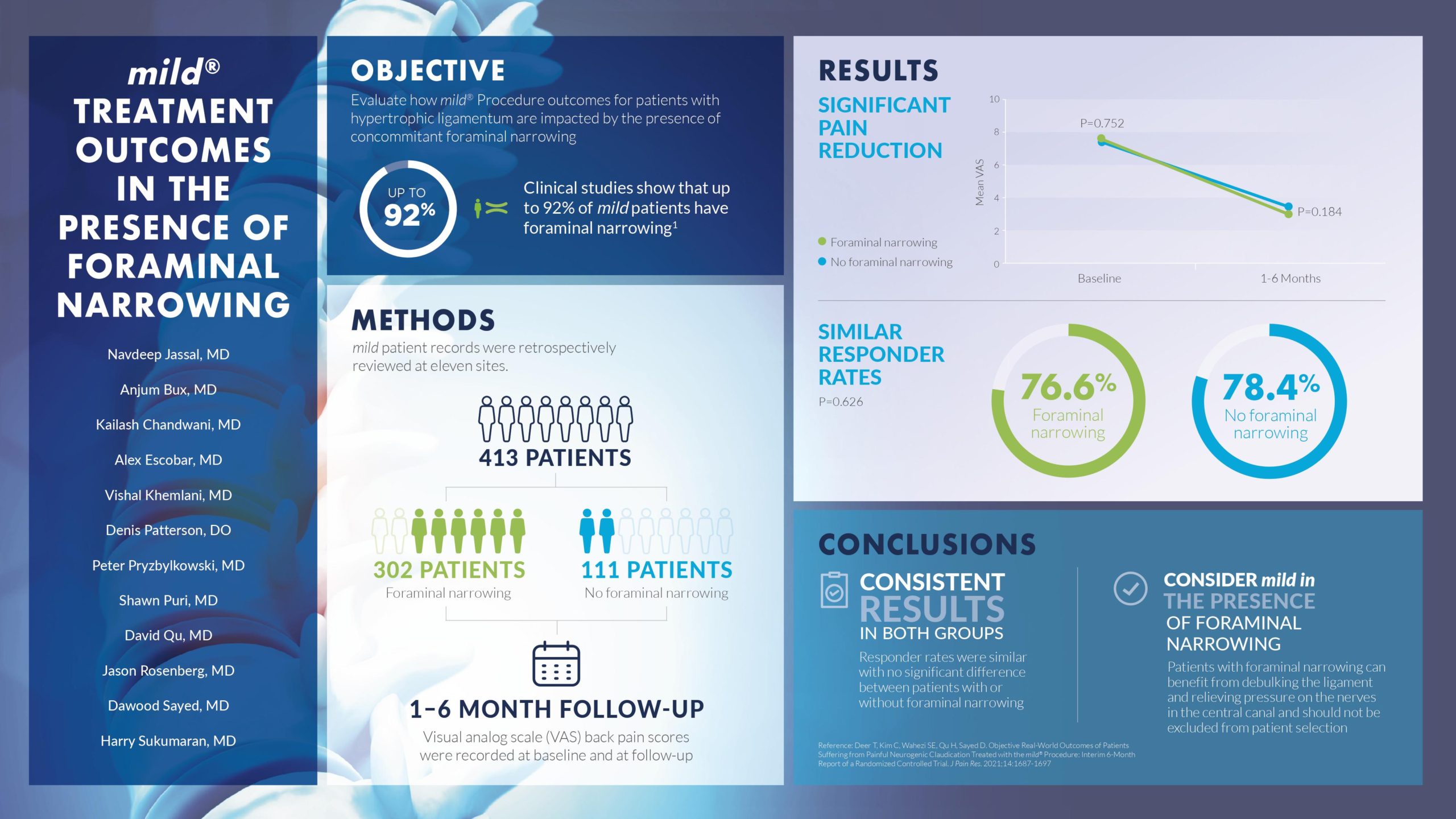
Watch Dr. Navdeep Jassal present his abstract from the New York & New Jersey Pain Medicine Symposium 2021 Conference, where he reviews the data and shares why mild® should be considered for patients impacted by the presence of foraminal narrowing as an adjunctive spinal comorbidity.
Are you ready to put your lumbar spinal stenosis patients on the path to long-term relief? Contact Vertos Medical and discover why leading interventionalists offer mild® in their practice.
Navdeep Jassal, MD (00:00)
My name is Navdeep Jassal. I practice in Lakeland, Florida as an Interventional Pain Physician, and my primary specialty is Physiatry. I’m going to talk a little bit about a poster presentation that will be presented at the New York and New Jersey meeting, talking specifically about the mild® treatment outcomes in patients with presence of foraminal narrowing.
So the onus for this poster was to really evaluate how the mild® Procedure, how their outcomes are, for patients with not only hypertrophic ligamentum flavum, but also how, when you do this mild® Procedure, patients are impacted even with the presence of foraminal narrowing. And we obviously know that this procedure is indicated to those with patients with LSS, with neurogenic claudication, we’re going to look for the ligament. We’re going to look for at least 2.5 millimeters of hypertrophic ligamentum flavum to debulk, but we want to make sure that we understand that physicians aren’t really excluding patients with also other co-factors such as foraminal narrowing. Because oftentimes we realize when you exclude such a patient population, you’re really excluding a patient to receive an outstanding therapy that’s not only safe, but efficacious. And here we actually show a poster to show those types of results.
So we have mild® patients’ recordings that were done across 11 sites or 11 centers with outstanding colleagues. We studied 413 patients retrospectively and out of these 413 patients, we saw 302 patients with foraminal narrowing, and we saw 111 patients with no foraminal narrowing. So if you think about the data, this really shows a typical type of patient population that presents with LSS, those with not just central canal stenosis, but also patients with co-factors that presents with neuroforaminal stenosis, those with facet hypertrophy, but really we’re going to really show that patients actually present, in fact, 302, presents with foraminal narrowing. And we study these patients out, you know, 1-6 months and we followed them up from a VAS (or visual analog scale) perspective. And these were recorded and compared to their baseline findings.
(02:18) From our baseline findings, we saw that these patients typically hovered in the 8 out of 10 or a VAS score of 8 out of 10. And we saw a significant improvement, at least a drop of about 50%. So from an 8 to a 4, about 1-6 months out. What was very interesting about this data specifically, was that there was really no significant difference in terms of the responder rate between those patients that received the treatment of the mild® with those that had foraminal narrowing versus those that did not have foraminal narrowing. In fact, those that had foraminal narrowing in our study were about 76.6% that actually had the responder rate. And then 78.4% that did not have foraminal narrowing had a good responder rate as well. So you can see, there was a very similar responder rate from those that had versus those that did not have foraminal narrowing.
And so from a conclusion standpoint, I really want to make this clear that because both responder rates were similar with no significant difference between patients with or without foraminal narrowing that underwent the mild® Procedure with a significant VAS pain reduction. I really want to hit home that patients with foraminal narrowing can really benefit, from the debulkment of the ligament. And, I think the hypothesis is that when we do this decompression or posterior decompression with the mild® Procedure, we are in fact relieving pressure on the nerves in the central canal. And so again, if we go back to a simple phenomena of a small change in volume is a large change in pressure, we can see how these patients do really well. So again, really trying to hit home that those patients with foraminal narrowing should not be excluded from such a safe and efficacious procedure for their LSS with neurogenic claudication symptoms.
So I think this data is tremendous because it should help those physicians that are skeptical about treating the mild® Procedure for those patients with co-factors. I know I talk to a lot of colleagues who are questioning whether they should offer a mild® Procedure with patients with not only the LFH (ligamentum flavum hypertrophy), but with co-factors of facet hypertrophy, or foraminal stenosis. And I would really challenge them to look at the data and show that, yes you should. If patients have foraminal stenosis or foraminal narrowing, you should treat the patient with the mild® Procedure if they are following signs and symptoms of LSS with neurogenic claudication, and they fit the criteria of something that you can debulk posteriorly with the mild® Procedure. I think it’s an incredibly safe procedure. We’ve proven time and time again, that it’s efficacious from RCTs. And I think this data will challenge you to think more about utilizing the mild® therapy for these patients with LSS.
Today, an increasing number of practices recommend their patients move to mild® after the first epidural steroid injection (ESI) fails, and it’s easy to see why. mild® provides patients relief from the symptoms of lumbar spinal stenosis (LSS) and has a safety profile equivalent to an ESI, but with lasting results. In the following article, we present the most common reasons physicians and Advanced Practice Providers (APPs) are moving their patients to mild® earlier in the treatment journey.
Ready to move to mild®? Skip to the end for 3 pragmatic solutions you can implement in your practice today to get started, and get your patients on the path to relief.
A recently published study conducted by the Cleveland Clinic Study explores how many patients were able to avoid surgical decompression after the mild® Procedure over a five-year period.
The study authors concluded that “the durability of mild® over 5 years may allow elderly patients with symptomatic lumbar spinal stenosis to avoid lumbar decompression surgery while providing significant symptomatic relief.” They also noted that “because the mild® Procedure demonstrated durability up to 5 years, it might also be speculated with caution, that appropriate patients should be encouraged to undergo the mild® Procedure as early as needed, rather than waiting until these patients are at an advanced age.”
No implants. mild® removes a major root cause of neurogenic claudication by debulking the hypertrophic ligamentum flavum, which reduces the compression of the nerves without leaving any implants behind.
No stitches. The entire procedure can be performed through a single, tiny incision the size of a baby aspirin (5.1mm).
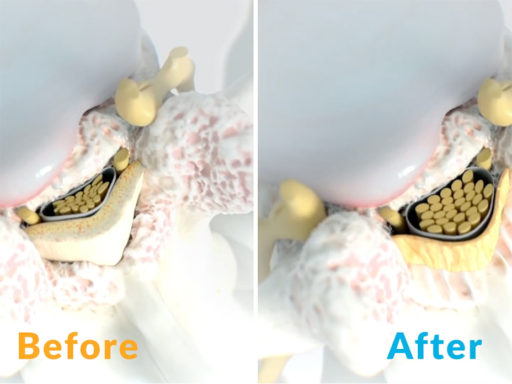
mild® does not significantly alter the structural anatomy of the spine or eliminate future treatment options
mild® offers a clinically proven safety profile equivalent to an ESI, even in patients with comorbidities.,
Unlike more invasive procedures that can require a lengthy recovery, mild® patients typically resume normal activity within 24 hours with no restrictions.

“When I went for the procedure, it was any other day. I went into the procedure. You feel nothing, and then you come back and you’re fine. I mean, it’s no big deal. There’s no pain, there’s no recovery, you just go home.”
-Nicky, mild® Patient
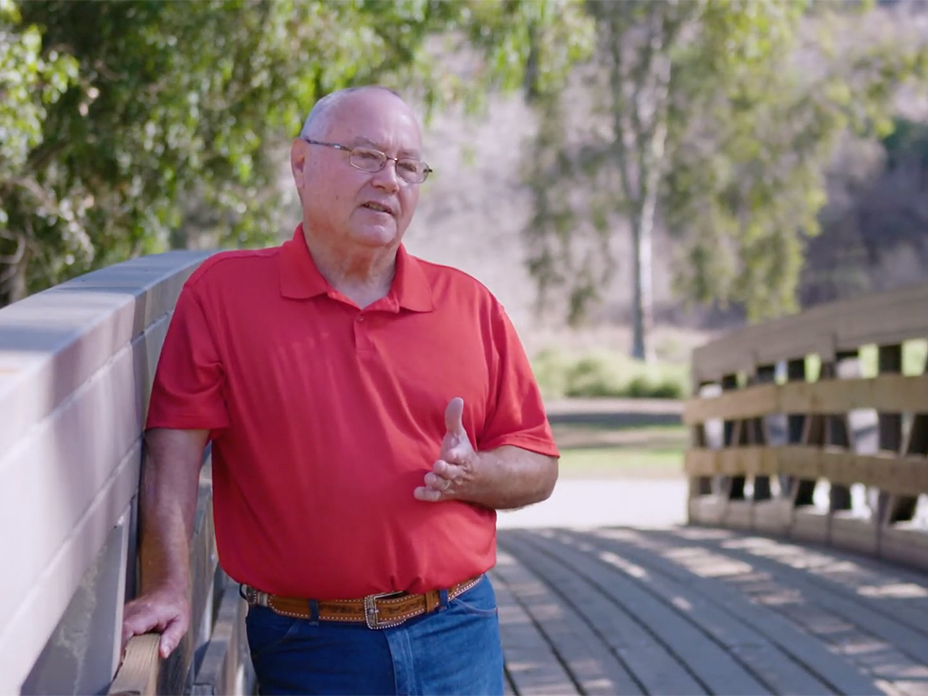
“By the time I walked out [after the mild® Procedure], I went home, and I could get out. The first thing I wanted to do was start doing stuff. That was a big moment in my life emotionally.”
-Ronnie, mild® Patient
LSS patients who receive a series of epidural injections may become frustrated or start to lose hope if the injections provide little relief or decreasing relief over time. While ESIs can sometimes deliver transient, temporary relief, they do not address the root cause of stenosis. The mild® Procedure decompresses, debulking the hypertrophied ligament, to reduce spinal canal narrowing, giving patients a new option to achieve long-term relief.
Janna L. Friedly et al. studied the long-term effectiveness of ESIs for LSS and the effect of repeat injections. The trial concluded that repeated epidural injections offer no additional benefit if injections in the first 6 weeks did not improve pain.
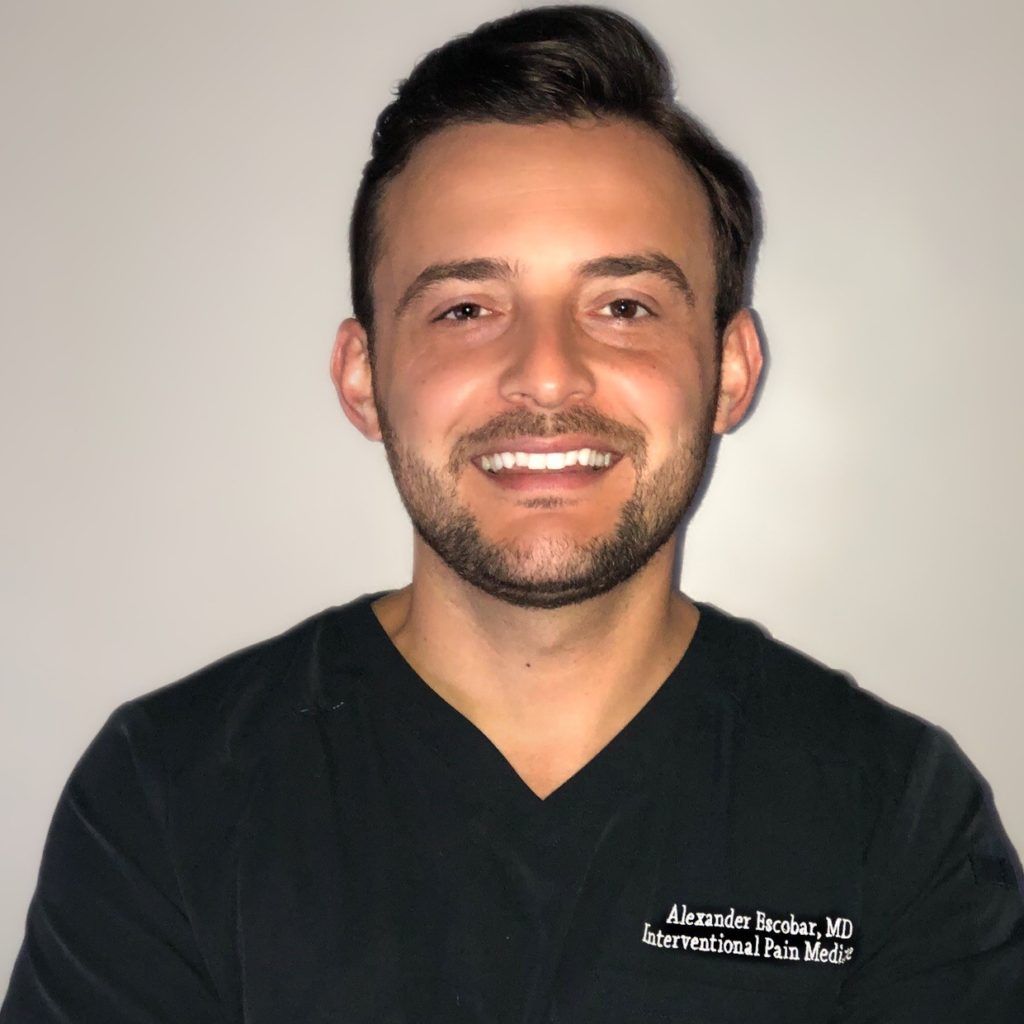
“If the patient has received ESIs in your practice and the outcomes were not efficacious, there is no reason to offer them another one. If a patient comes to you from another practice, and has recent history of epidural steroid injections, move to mild®. They’re likely seeking an alternate option, and mild® is something that can provide them hope.”
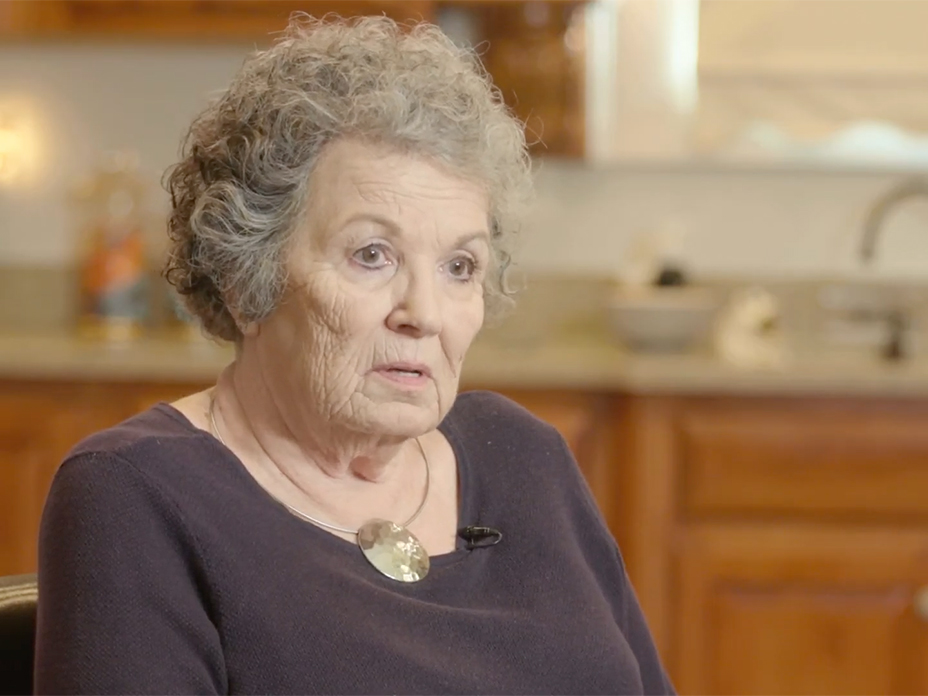
“The first epidural lasted about three months and then the pain was back. I went for the second epidural, and it didn’t last two weeks. My physician said, ‘Well, you can have one more.’ I said, ‘No, I’m finished with them, I want the mild® Procedure.’”
Here are a few tips to help you successfully integrate mild® into your practice.

When reviewing a patient’s MRIs/CTs, be sure to identify hypertrophic ligamentum flavum (HLF). HLF ≥ 2.5 mm can be readily identified and is surprisingly common, contributing to up to 85% of spinal canal narrowing.
Introducing patients to mild® early in their treatment journey can help them feel assured that they have effective options if ESIs don’t provide the relief they need. Dr. Jason Pope of the Evolve Restoration Center confirms, “By presenting mild® as part of the treatment plan from the start, patients have more confidence that we are going to be proactive in their care, and make sure they have the opportunity to access advanced LSS treatment options that offer excellent outcomes.”
Many practices that offer mild® ensure that physicians and Advanced Practice Providers (APPs) alike are trained to identify patient candidates who may benefit from the mild® Procedure. Jane Hartigan, an APP in a leading Northern California pain management practice recommends asking proactive questions like, “Does hunching forward significantly relieve the pain you’re feeling?”, or “Do you feel pain in your back and legs when standing or walking?” By understanding your patient’s current experience with LSS, their treatment history, and functional goals, you can readily spot the many patients in your practice who may benefit from the mild® Procedure.
Physicians and practices treating lumbar spinal stenosis (LSS) patients with epidural steroid injections (ESIs) will likely recognize a common “condition” among serial ESI patients that our practice typically refers to as “Epidural Exhaustion.” Epidural Exhaustion is typically seen in patients who have tried multiple injections but have experienced only short-term functional improvements with little to no pain relief. Many times, LSS patients who do not improve after a single ESI or series of ESIs can become frustrated, or begin to lose hope in ever feeling relief from their spinal stenosis symptoms.
While “Epidural Exhaustion” is remarkably common among lumbar spinal stenosis (LSS) patients, it is avoidable. In our practice, we have found that moving to mild® (Minimally Invasive Lumbar Decompression) earlier in the patient journey helps drive positive long-term clinical outcomes and stronger patient satisfaction. Today, we have changed our practice workflows to move more patients to mild® after their first failed ESI. We proactively communicate the benefits of the mild® Procedure to our patients at the time of diagnosis or before they begin their treatment journey in our practice, so that they understand the breadth of their treatment options. With the availability of mild® as an early treatment option for more spinal stenosis patients, we can reduce incidences of ESI exhaustion and put more of our LSS patients on the path to long-term relief.
Although repetitive epidural steroid injections are still the standard of care in many practices and instilled during our training, the data show that serial ESIs offer little benefit to long-term patient outcomes.
As noted by Heidi Younan, Director of Patient Marketing & Practice Integration at Vertos Medical, we already know that epidurals are not capable of “curing” neurogenic claudication, which is present in 94% of patients with lumbar spinal stenosis. While repetitive ESIs deliver some chemical benefit and can offer transient, temporary relief for radicular components, ESIs do not address a major root cause of stenosis. Decompression is required to reduce narrowing/triangulation and relieve pressure in the central canal.
A 2016 study conducted by Janna L. Friedly et al., studied the overall long-term effectiveness of treatment with epidural corticosteroid injections for lumbar central spinal stenosis and the effect of repeat injections on LSS patient outcomes through 12 months. The multicenter, double-blind, randomized, controlled trial with 400 patients concluded that repeated epidural injections offer no additional benefit if injections in the first 6 weeks did not improve pain. Therefore, performing multiple ESIs on patients who did not benefit from the initial injection is essentially delaying treatment that can provide beneficial and long-term outcomes.
Because of its effectiveness and safety profile, I strongly recommend moving to mild® earlier in the patient journey, after the first failed ESI. Recognizing that up to 85% of spinal canal narrowing is the result of hypertrophic ligamentum flavum (HLF), there is tremendous benefit in being able to debulk the HLF and restore space in the spinal canal, thus reducing compression of the nerves. The minimally invasive mild® Procedure enables our practice to offer a treatment option that is a step up from ESIs with the same low complication rate, but with excellent effectiveness and lasting results.
Ms. Younan also highlights that clinical studies of mild® have demonstrated clinically meaningful, statistically significant improvements in mobility, Oswestry Disability Index (ODI), and pain reduction on the numeric pain rating scale (NPRS). More recent 5-year data shows that after undergoing the mild® Procedure, only 12% of patients required surgical decompression at the same level over 5 years. Stated differently, mild® gives the potential to help 88% of patients avoid surgical decompression surgery for at least 5 years, while providing symptomatic relief during that time.
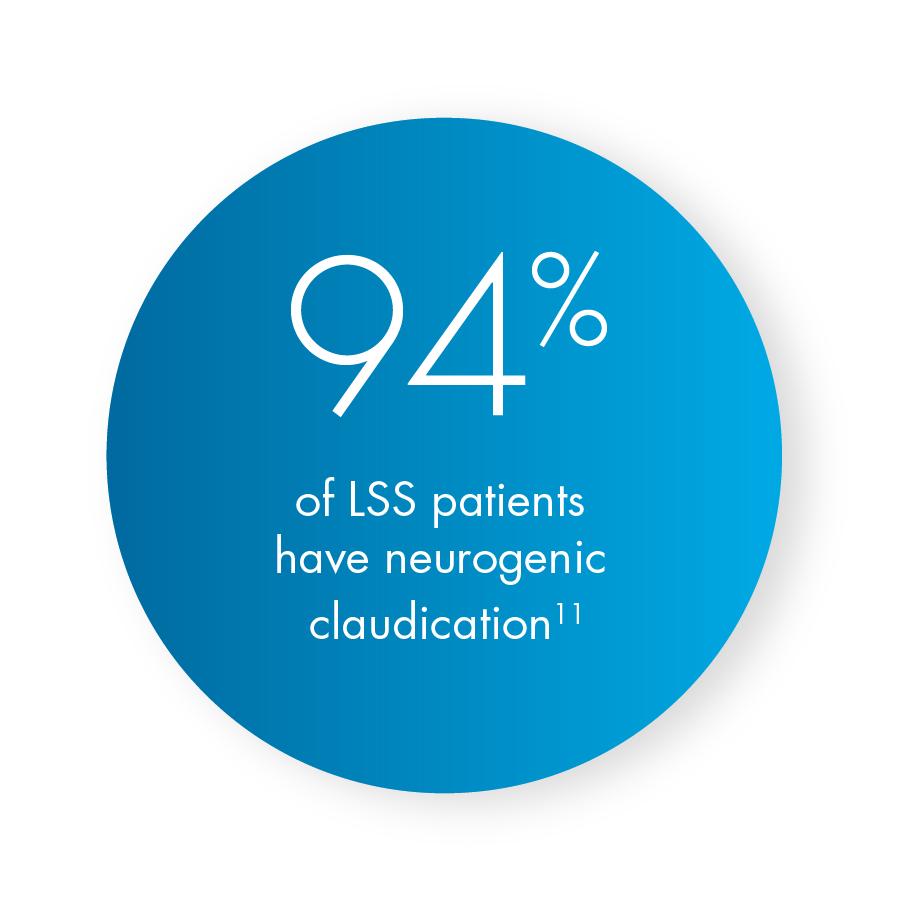
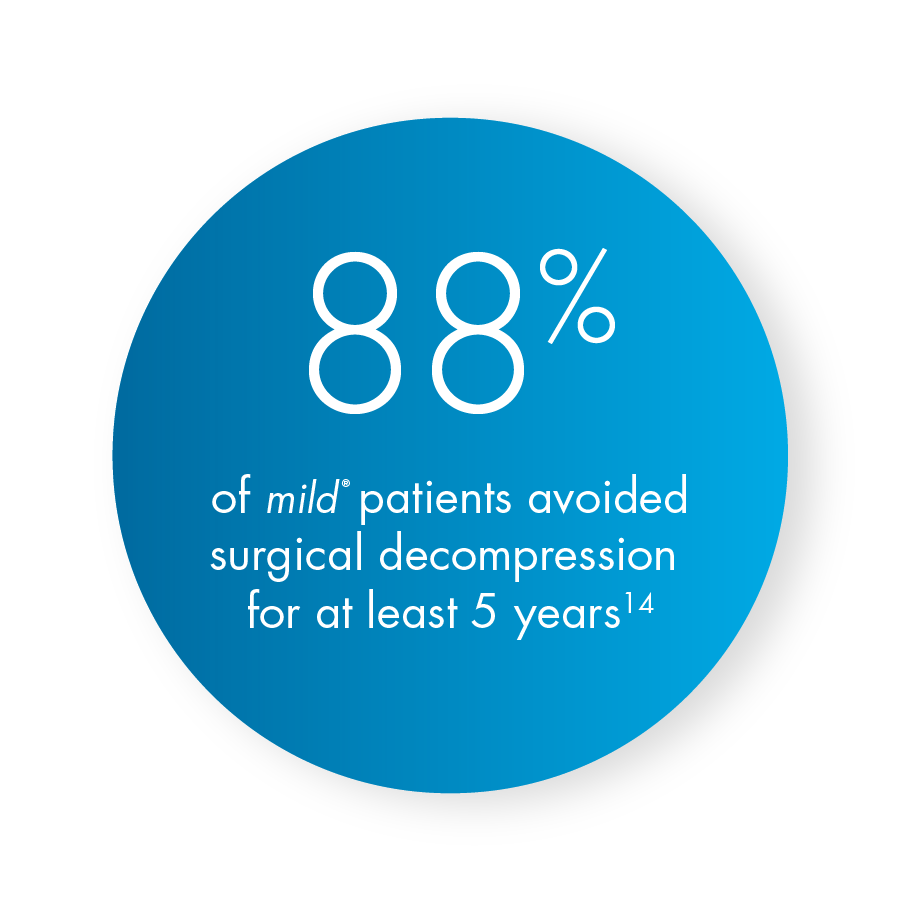
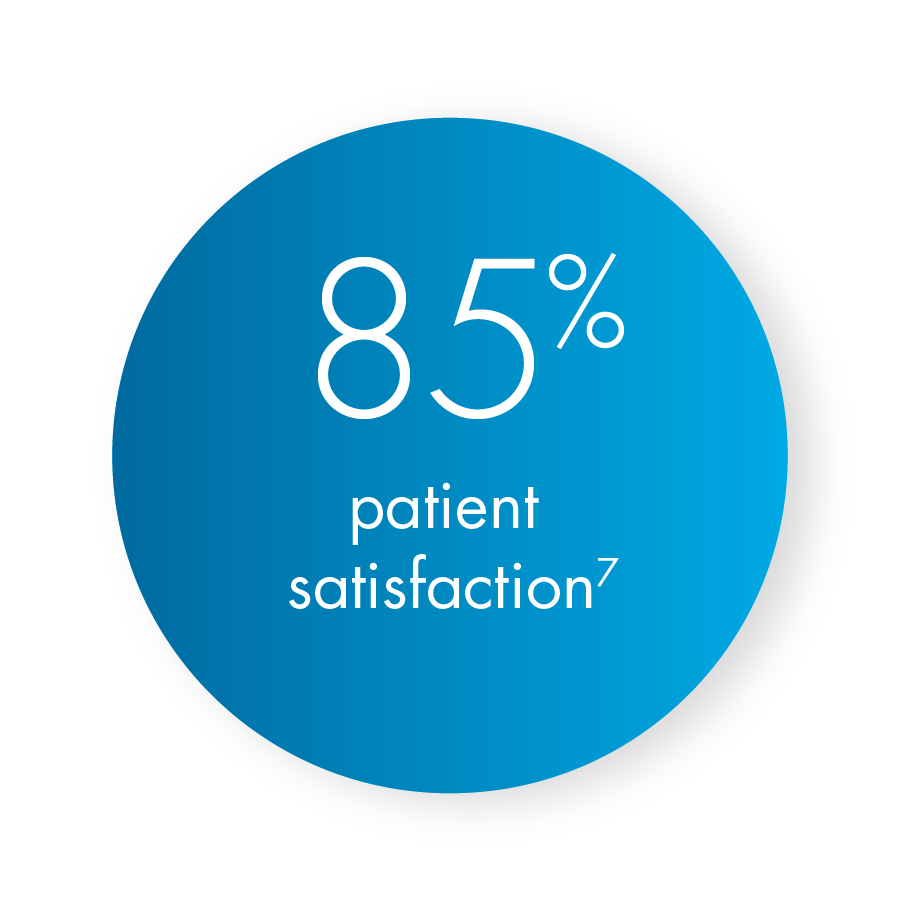
Beyond the individual clinical benefits, I also advise other pain specialists that there are many practice-driven reasons to offer mild® in lieu of serial epidural steroid injections. The MiDAS ENCORE level 1 data demonstrated an exceptionally high 85% patient satisfaction rate among patients who received the mild® Procedure. Patient satisfaction is a key benchmark in our practice. With the mild® Procedure, we have seen tremendous patient satisfaction, and we know that those patients tell their friends, relatives, and neighbors about their positive results, which increases word-of-mouth to our practice.
My goal as a physician is always to assess where the patient is in their treatment journey, the impact of lumbar spinal stenosis symptoms on their lifestyle, their priorities for the procedure (such as a minimally invasive approach or a short recovery time), and their treatment history to determine the best path forward for that individual.
This purpose of this article is certainly not to challenge any and all use of ESIs within the modern pain or spine practice. ESIs can be an effective tool and are a critical part of our practice armamentarium. For some patients, ESIs offer significant benefits; however, evidence and experience demonstrate that ESIs are not a one-size-fits-all solution. Many patients with LSS fail to achieve significant pain reduction, while others who do experience pain reduction or functional improvements find those benefits to have limited durability.
In our practice, we still commonly begin a lumbar spinal stenosis treatment plan with a conservative approach to determine if an ESI will effectively reduce the symptoms of LSS. Once we understand how our patient responds to an ESI, we can determine the best treatment plan for the patient. If they have a good result with an ESI, we suggest that they resume normal activities and self-monitor for changes over time. On the other hand, if they do not see significant benefit from the initial ESI, I will strongly consider them as a candidate for mild®, and barring any contraindications, we typically schedule their mild® Procedure within a few weeks.
A powerful message for patients looking for significant relief is that we will start their LSS treatment with an ESI, but we’ll also be able to know very quickly if the epidural steroid injection is going to be successful for them. When patients understand that they have other minimally invasive, nonsurgical options, they may be less concerned if they experience limited relief from their first ESI.
The key question is, “At what point can we reliably assess whether an individual patient will benefit from serial ESIs?” Here again, we can look to the Friedly data showing that repeated epidural injections offered no additional long-term benefit if injections in the first 6 weeks did not improve pain. Based on this data and the results we’ve seen first-hand in our own practice, we know that we can assess our LSS patient results post-ESI and determine whether we should move them to mild® earlier in their treatment journey.
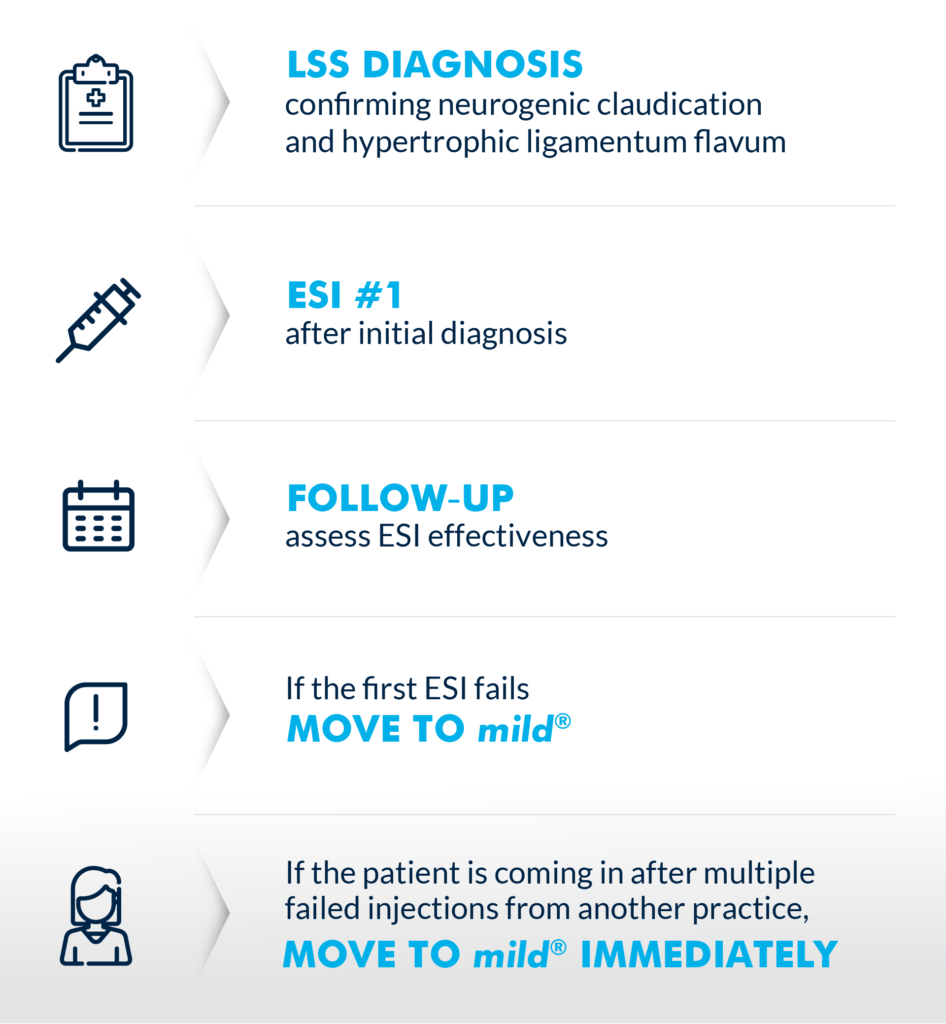
(Graphic courtesy of Vertos Medical)
One of the most significant ways our practice has shifted after the adoption of mild® is that we now evaluate most patients as potential mild® candidates. If we suspect LSS, we present mild® as a treatment option from the start. In making this shift, we have discovered a few clinical and workflow pearls that optimize success across the practice.
1. Train staff to recognize patient symptoms
Because LSS is especially common among adults over 60 years of age, and our practice treats a high volume of senior patients, we have found that many of our existing and new patients are excellent candidates for mild®.
Our practice trains our APPs and other support staff so they can immediately recognize the signs and symptoms of LSS independently. Of course, we ultimately diagnose LSS and neurogenic claudication with the support of imaging, but I always remind our staff and patients that imaging can’t show pain. As a healthcare team, we need to be proactively asking questions like, “Does hunching forward significantly relieve the pain you’re feeling?” or “Do you feel pain in your back and legs when standing or walking?” If the answer to either question is yes, we know there’s a good chance that patient may be candidate for mild®.
Younan also notes that the Vertos team has developed resources and training to support APPs. All resources are available through your Vertos sales representative.
2. Look for the ligament
When reviewing a patient’s MRIs/CTs, a simple rule we use is “look for the ligament.” Hypertrophic ligamentum flavum is a common problem that contributes up to 85% of spinal canal narrowing. We have trained our APPs to apply this rule while reviewing images to help identify patients who may benefit from the mild® Procedure.

In the image, the thickened ligament can be seen clearly, resulting in compression of the spinal cord nerves.
3. Present mild® in your initial LSS treatment plan
When we work with patients, we make sure they know that our focus is on improving their functionality and reducing pain. We are clear from the start that we’re going to evaluate their symptoms, treatment history, and goals to determine their best treatment pathway based on the latest evidence and techniques.
Patients are generally open to the idea that a therapy that works for one patient might not work for them. So, I typically tell the patient, “We are going to start with a single epidural, and we’ll be able to know quickly if the epidural is going to be effective for you.” I also let them know that if they do not experience a significant improvement after the epidural, or if those results wear off after a short period, we can still help them with proven, minimally invasive options. Then, I tell them about the mild® Procedure, and how it offers a safety profile similar to an epidural, but with lasting results.
By presenting mild® as part of the treatment plan from the start, patients have more confidence that we are going to be proactive in their care and make sure they have the opportunity to access advanced LSS treatment options that offer excellent outcomes.
Overall, the addition of mild® has been a real game-changer in our practice. We see mild® as a safe and effective alternative to serial ESIs that drive long-term patient improvements and high patient satisfaction—a treatment we make available to as many patients as possible, as early as possible. I regularly tell other interventional pain specialists to incorporate mild® in their practice, and once they see the impact it has on their patients, they understand why we are so passionate about moving to mild® after failure of the first ESI.
About Dr. Jason Pope
 Jason Pope, MD, is an Interventional Pain Physician trained in Pain Medicine at the Cleveland Clinic with board certifications in Anesthesia and Pain Medicine. He completed an Anesthesiology Residency at Vanderbilt University Medical Center and received his medical degree from the Indiana University School of Medicine. Dr. Pope is the Founder and CEO of Evolve Restorative Center in Northern California and serves as an expert reviewer for the Medical Board of California. Dr. Pope also serves as President Emeritus and Chairman for the Pacific Spine & Pain Society (PSPS), President Elect for the American Society of Pain & Neuroscience (ASPN), Director at Large and Chairman for the International Neuromodulation Society (INS), and Chairman for the North American Neuromodulation Society (NANS).
Jason Pope, MD, is an Interventional Pain Physician trained in Pain Medicine at the Cleveland Clinic with board certifications in Anesthesia and Pain Medicine. He completed an Anesthesiology Residency at Vanderbilt University Medical Center and received his medical degree from the Indiana University School of Medicine. Dr. Pope is the Founder and CEO of Evolve Restorative Center in Northern California and serves as an expert reviewer for the Medical Board of California. Dr. Pope also serves as President Emeritus and Chairman for the Pacific Spine & Pain Society (PSPS), President Elect for the American Society of Pain & Neuroscience (ASPN), Director at Large and Chairman for the International Neuromodulation Society (INS), and Chairman for the North American Neuromodulation Society (NANS).
About Heidi Younan
 Heidi Younan is the Director of Patient Marketing & Practice Integration at Vertos Medical. A critical member of the Vertos team for over a decade, Ms. Younan works with clinicians, APPs, and patients to support the successful integration of the mild® Procedure in pain practices and help more patients experience the life-changing benefits of mild®. Ms. Younan also contributed portions of the clinical content within this article.
Heidi Younan is the Director of Patient Marketing & Practice Integration at Vertos Medical. A critical member of the Vertos team for over a decade, Ms. Younan works with clinicians, APPs, and patients to support the successful integration of the mild® Procedure in pain practices and help more patients experience the life-changing benefits of mild®. Ms. Younan also contributed portions of the clinical content within this article.
The objective of the study “Use of Epidurogram is Not Necessary for Safe, Minimally Invasive Direct Lumbar Decompression” was to investigate the safety of using osteal landmarks vs an epidurogram to establish a visual safety barrier prior to decompression with the mild® Procedure. A retrospective data analysis was performed on 147 patients that compared those receiving an epidurogram with performance of the mild® Procedure versus those that did not. View the abstract poster below to learn more about the outcomes.
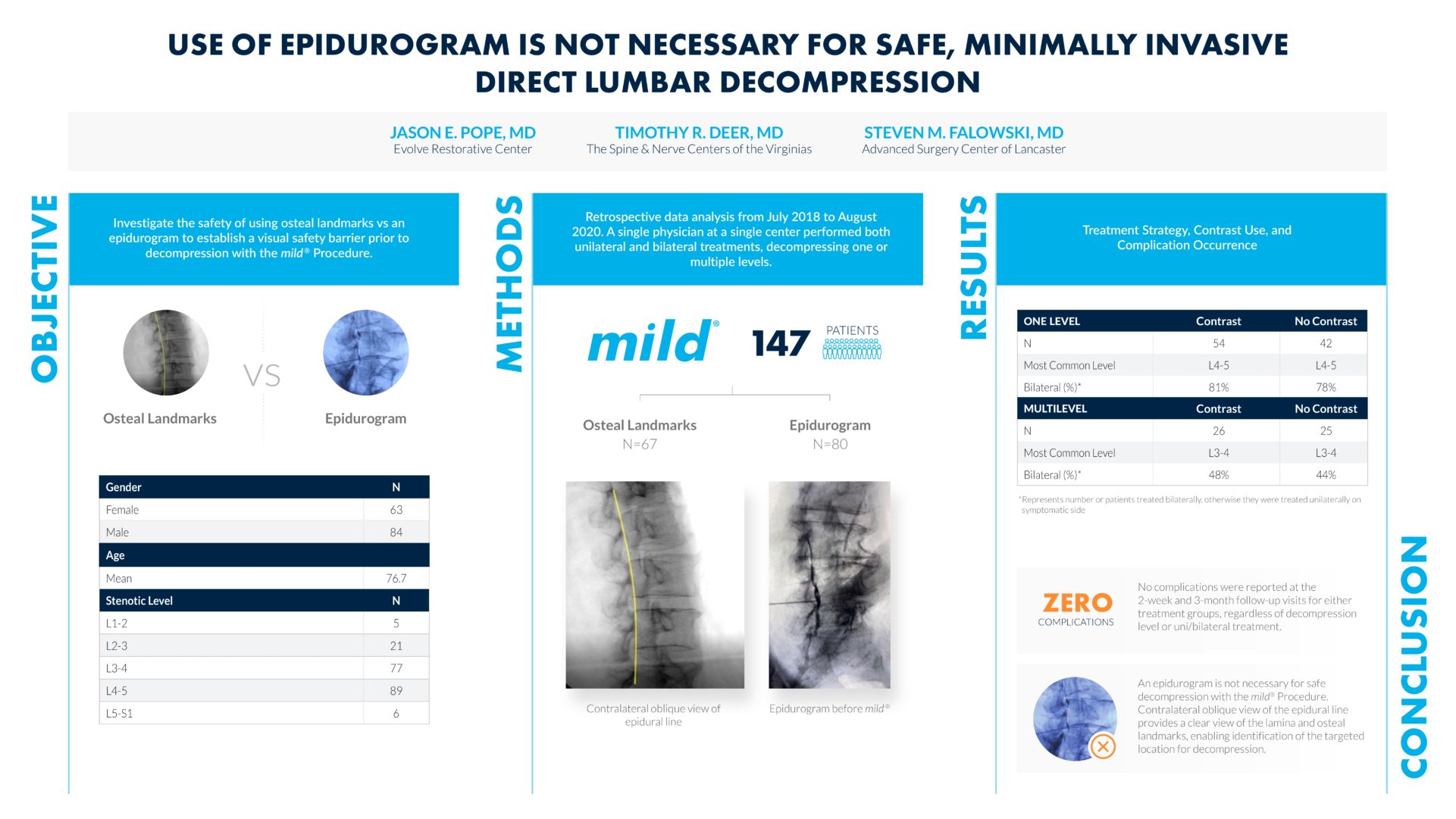
Watch Dr. Jason Pope present his abstract from the American Society of Pain and Neuroscience’s (ASPN) Third Annual Conference where he shares why the use of an epidurogram is not necessary for safe decompression with the mild® Procedure.
Eager to further understand the mild® Procedure and how it can put your lumbar spinal stenosis patients on the path to long-term relief? Contact Vertos Medical and discover why leading interventionalists offer mild® in their practice.
This study was recently published in the Journal of Pain Research, click here to view.
Jason Pope, MD (00:00)
Well, welcome everyone. My name is Dr. Jason Pope. I have a practice in Northern California serving Napa, Sonoma, Mendocino counties and I’m here today to talk a little bit about an innovative strategy that we had in performing the mild® Procedure. And the question that we were trying to answer with this was essentially, “Is the epidurogram necessary when executing the mild® Procedure on patients, whether you’re going to perform a single level or a multilevel strategy?” And so we retrospectively looked at 147 patients. So we can see here the female to male breakdown along with a median age of around 77. And we looked at patients that either got the epidurogram with performance of the mild® [Procedure] versus those that did not. And we did so equitably across the patient population that we were serving. And as we can see with a stenotic level, clearly the most common areas that were performed were at L3-4 and L4-5 and that’s no surprise. And then we looked at patients whether they were done as a single level or a multilevel. And we can see here that the breakdown of these patients where 54 patients received contrast, 42 non-contrast, in a single level. And the most common level that was performed was at L4-5. But what was also very interesting was in this retrospective review, again, of about 147 patients, about 80% of them had the procedure done bilaterally if it was at a single level. And interestingly enough, when we did a multilevel mild®, and in this cohort, it represented at least two levels, the most common level that was the index level of where it was treated was at L3-4 and bilaterally, this was performed nearly 50% of the time. So when people do multiple levels of [the] mild® Procedure, the unilateral reality based on symptoms changes a little bit as compared to if you were doing a single level.
(02:27) And again, this was done over a total cohort of 147 patients. And the way that this came about and again, we highlighted the fact that when we looked at the use of epidurogram in managing patients with spinal stenosis symptomatically, with the mild® Procedure, it wasn’t clear that it really offered an increase in safety. And it wasn’t clear that it highlighted when the decompression was completed because epidural flow after decompression doesn’t necessarily increase after the ligament is trimmed or resected. So we looked at trying to simplify the procedure, and this was done just by using the osteal landmarks. And we can see the facet line and the laminar line in the middle section of the abstract presentation here. And I can say with confidence, using osteal landmarks alone as compared to the epidurogram, and we use the midline incision, the refined Streamlined Technique that you all have come to know and love, that in performing this, there were zero complications, as defined as problems with infection, nerve injury, allergy to contrast, which is something that can happen, but clearly in this cohort, it did not.
And so there were zero complications performing either one level or multilevel [mild®], either unilaterally or bilaterally with contrast or without contrast. So this underscores the importance and the strategy that if one chooses or elects to not use the epidurogram in performance of the mild® [Procedure] you can do so safely, based on this patient cohort. So again, appreciate your time. I want to also thank my co-authors associated with this project, Dr. Timothy Deer and Dr. Steven Falowski. And I want to also thank the Vertos team for helping with the assembly of the abstract. So with that, thank you.
The objective of “Minimally Invasive Decompression for Lumbar Spinal Stenosis: The Impact of Moving to mild® Directly or After Initial ESI Failure on Clinical Performance—A Six Center Retrospective Report” was to understand how epidural steroid injection (ESI) use prior to mild® impacts patient outcomes. In this clinical study, 145 patients were divided into 2 groups receiving either 0-1 or 2+ ESI procedures prior to mild®. View the abstract poster below to discover the results of the retrospective report and learn why moving to mild® after the first ESI fails can put more spinal stenosis patients on the path to long-term relief.
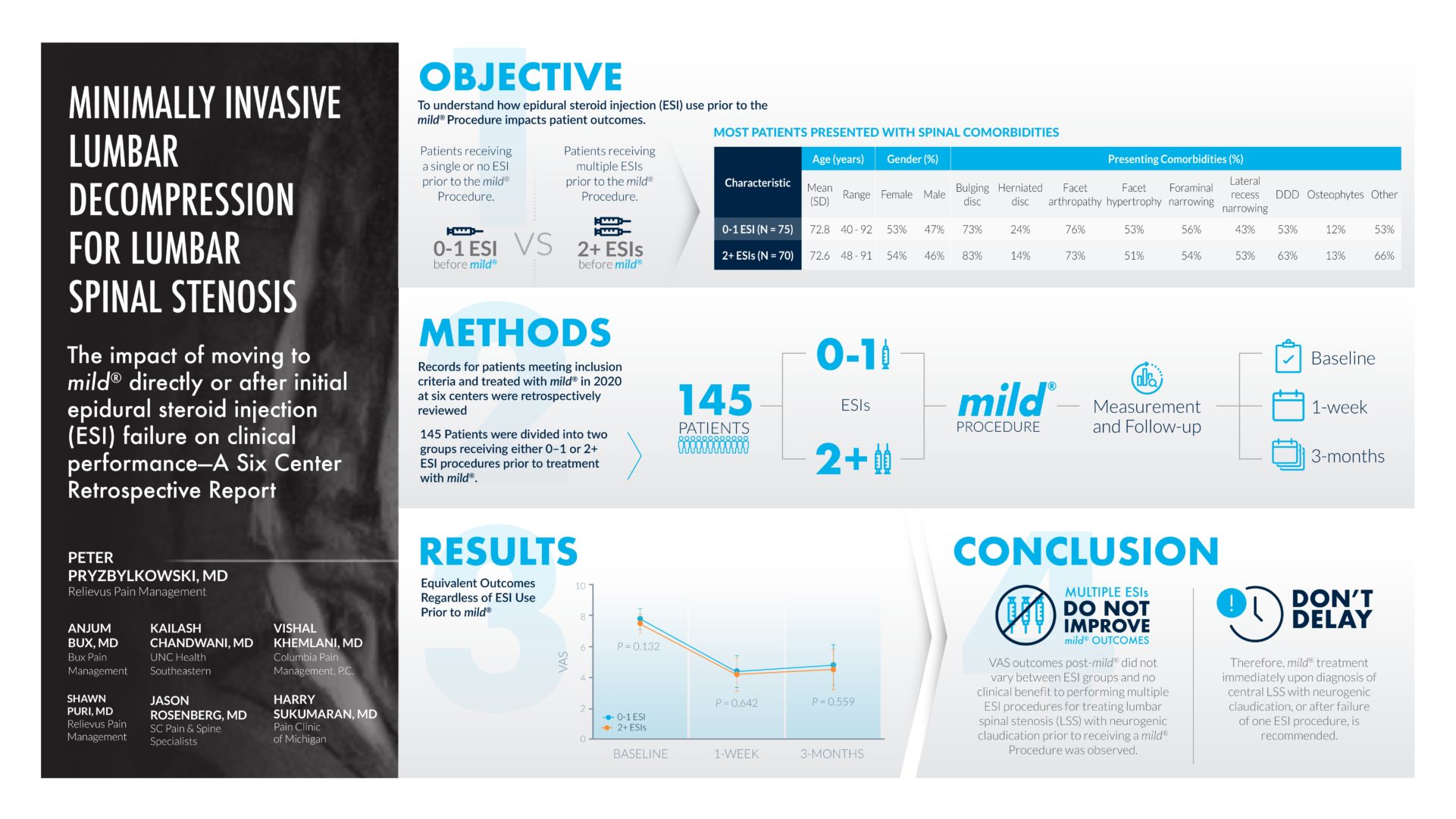
Watch Dr. Peter Pryzbylkowski present his abstract from the American Society of Pain and Neuroscience’s (ASPN) Third Annual Conference in which he reviews the data and shares why he moves his lumbar spinal stenosis (LSS) patients to mild® earlier in the treatment journey.
Do you want to learn more about mild® and challenge your thinking around ESIs? Contact Vertos Medical for more information about the minimally invasive mild® Procedure and read about Dr. Jason Pope’s experience dealing with “Epidural Exhaustion” in his new blog.
Peter Pryzbylkowski, MD (00:00)
My name is Dr. Peter Pryzbylkowski. I’m a board certified anesthesiologist and board certified interventional pain specialist with the Relievus Pain Management Group, based out of the Philadelphia area. I want to thank Vertos, number one, for getting me involved with this study.
So, the objective of this study was to determine whether or not, no epidurals, one epidural versus a series of epidurals, made any difference in terms of pain relief, pain reduction, post-mild® Procedure. So, this is a nice clinical study because it kind of expands the bandwidth of practices across the country.
So, we have 6 total centers, 145 patients, that was enrolled in this study. Basically it was a retrospective review of patient charts we all did, and it’s important to notice, specifically under the objective tab, that the comorbid conditions coexisting, with patients with lumbar spinal stenosis with neurogenic claudication, is noted there, so these patients had bulging discs, herniated discs, facet arthropathy, facet hypertrophy, narrowing of the foramen, degenerative disc disease, osteophytes, and other comorbid conditions, so even though these patients had other comorbid conditions that are listed there, these patients still had good clinical and durable clinical results after post decompression procedure.
So, you can see the average ages there, the breakdown of male versus female, and those comorbid conditions I had mentioned before. And the groups we’re looking at, so it’s a group of patients who either had no epidurals or one epidural, versus two or more epidurals. So 145 patients total, were looked at in this retrospective review, and we followed the results, both at the baseline pre-procedure, one week post-operatively, and 3 months after mild® Procedure was performed. And, what you can see in the results section is that multiple epidurals versus no epidurals or one epidural did not make a difference in terms of VAS scores post-mild® Procedure.
(02:13) So, really what this is telling us as pain providers, is it doesn’t matter if you do no epidurals, one epidural or multiple. It’s not gonna affect your clinical outcome post-mild® Procedure, so the take home message from a retrospective review like this is that really, doing epidurals, a series of epidurals, really, we know as pain doctors, doesn’t really provide long-term clinical benefit, and it’s not gonna affect the outcome post-lumbar decompression. So if you have a patient with lumbar spinal stenosis with neurogenic claudication, they have ligamentum flavum hypertrophy, they’re candidates for the mild® Procedure and it’s important to do the procedure sooner rather than later ’cause all you’re really doing with a series of epidurals is delaying appropriate care, so kind of the message that this has hit home in my own personal practice is, I’ve really been able to go to all my advanced providers and say, “Listen, if we have patients who are kind of stuck in this rut of doing multiple epidurals, epidural, epidural, epidural for their lumbar spinal stenosis, we should really be considering doing the mild® Procedure to help give them good long-term benefit, rather than giving them multiple injections, which increases the risk of infection, increases the risk of an untoward side-effect.” Obviously every time we do a procedure there’s always a risk.
It’s nice to do a procedure that can give them long-term benefit, so if you have patients that have spinal stenosis, it’s just important to keep in mind mild® as a first treatment step rather than treatment that you would consider down the road for patients with spinal stenosis with neurogenic claudication. So I would not delay treating these patients when they come to my clinic. So, I used to do an epidural, 2 epidurals, 3 epidurals, for patients with spinal stenosis with neurogenic claudication. The outcomes really were hit or miss, so for me personally, I’m offering these patients percutaneous decompression in the form of the mild® Procedure a lot sooner than I used to 2-3 years ago. And the data from this retrospective study kind of shows that by doing the procedure sooner rather than later, not delaying care, we can give them good long-term benefit, give them a procedure that’s actually indicated for their pathology and approved for their pathology, rather than delaying care with a series of epidurals.
The following study, “Single-Center Comparison of Streamlined Technique Safety for mild® Procedure: Measuring Incidence of Postoperative Complications Compared to Standard Approach,” evaluates the safety of the Streamlined Technique in patients treated consecutively by a single center. As the mild® Procedure has become more widespread in clinical practice, there has been an evolution from the Standard Approach to the Streamlined Technique, a less invasive procedural approach. Dr. Navdeep Jassal and Christine Christensen, MSN, APRN, of the Spine & Pain Institute of Florida, evaluated 78 mild® patients treated using either the Streamlined Technique or the Standard Approach and measured the occurrence of postoperative complications. View the abstract poster below to discover the results of this study, and learn why the mild® Procedure should be considered the first-line intervention for patients with lumbar spinal stenosis after conservative treatments have been exhausted.
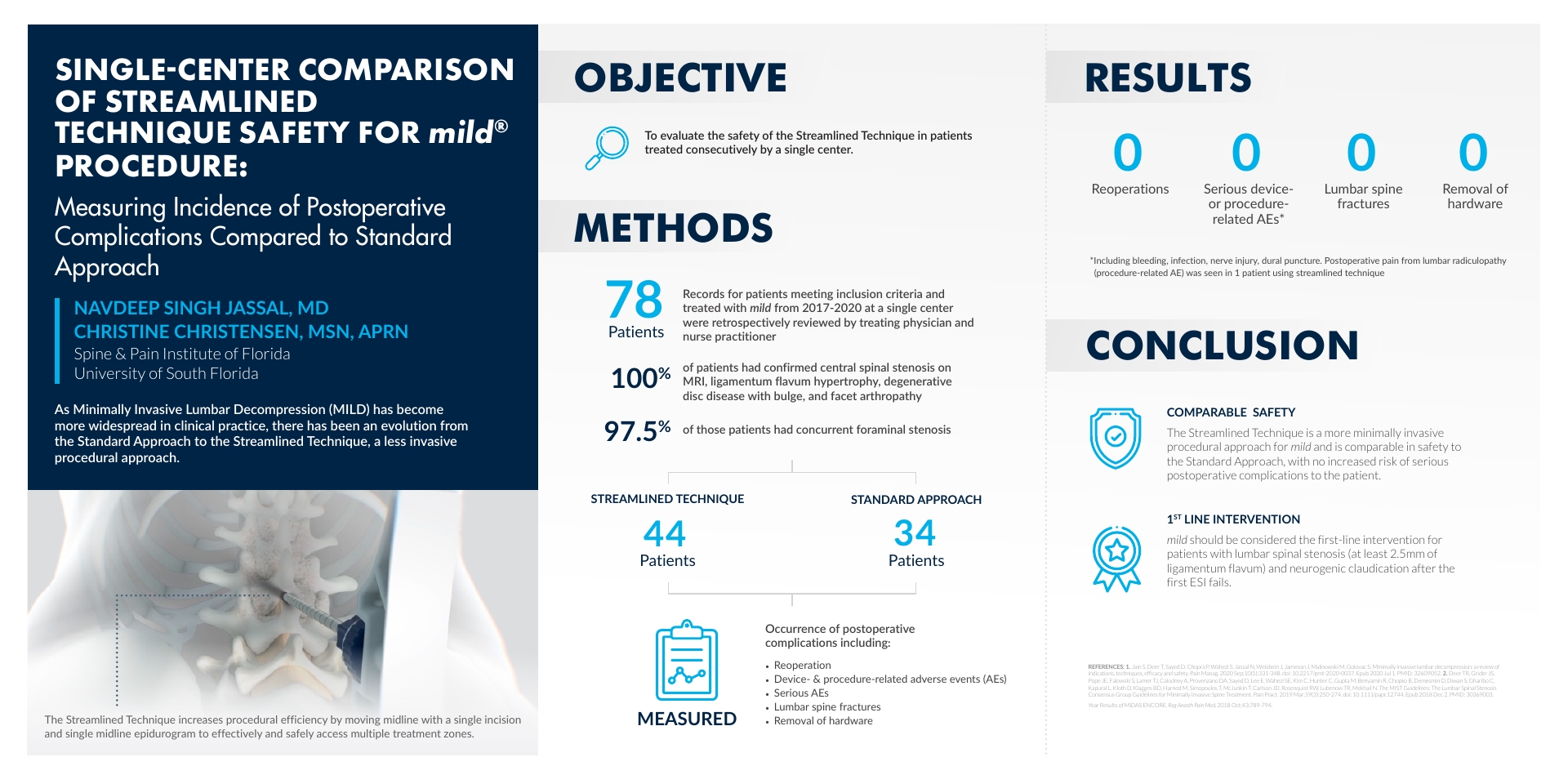
Watch Dr. Jassal and Christine Christensen present their abstract from the American Society of Pain and Neuroscience’s (ASPN) Third Annual Conference, where they discuss why the Streamlined Technique is a more minimally invasive procedural approach for the mild® Procedure and comparable to the Standard Approach in terms of its safety profile.
Eager to further understand the mild® Procedure and the technique described above? Contact Vertos Medical to learn more about the Streamlined Technique or check out the animation and physician experience from Dr. Jassal in this Procedure Evolution blog.
Navdeep Jassal, MD (00:01)
Hello, my name is Navdeep, Dr. Navdeep Jassal from the Spine Institute of Florida in Lakeland, Florida. I’m here to discuss a little bit about a study that is very meaningful to myself and especially my patients in my practice. We’re going to talk a little bit about the Streamlined Approach for the minimally invasive lumbar decompression or the mild® Procedure, and how that’s really changed the way I’ve practiced. We’re going to talk specifically about the safety profile for this particular technique and its comparison to the standard or the classical approach that we’ve used for years.
So what we did was we did a retrospective chart review on our patients and we just wanted to measure the incidence of postoperative complications of the Streamlined Technique compared to the Standard Approach. And we know that the Standard Approach is a very safe as well as an efficacious procedure, and we’ve seen this really time and time again, but classically we’ve seen this from the RCT from the MiDAS ENCORE study, which showed the approach of the Standard Approach, comparing the epidural steroid injection, which is the standard procedure that you do for patients with lumbar spinal stenosis with neurogenic claudication. And then comparing that with the mild® or the minimally invasive lumbar decompression procedure.
I wanted to take this a step further and I wanted to make sure that the complication rate was pretty much the same, which was extremely rare, comparing the Streamlined Approach with the Standard Approach and that’s simply what we did in this retrospective chart review in our practice. I’m going to turn it over to Christine Christensen, who is going to talk a little bit about the data and dive really further into the data because I think it’s just quite interesting.
Christine Christensen, MSN, APRN (02:06)
Hi, I’m Christine Christenson. I’m the Nurse Practitioner that works with Dr. Jassal here in Lakeland, Florida. As part of my practice here, Dr. Jassal was able to include me in generating data and analyzing that data for our research study here looking at the efficacy and safety of the Streamlined Technique. Now, data collection for this study consisted of reviewing charts on 78 patients that had the mild® Procedure performed for them. Dr. Jassal started doing the Streamlined Technique after certain dates.
So we looked at the date and the operative notes for those patients to verify that they did get the Streamlined Technique in the operating room. Of those patients, 100% had confirmed central spinal stenosis on MRI. They also had ligamentum flavum hypertrophy, degenerative disc disease with disc bulges, and facet arthropathy. Of the 78 patients, 97% had concurrent foraminal stenosis. So when we broke that down to the patients who had the Streamlined Technique after Dr. Jassal was trained in proper performance of the technique, we had 44 “streamlined” patients and then 34 patients who had the Standard Approach for the mild® Procedure.
So we took the 44 patients with the Streamlined Technique and the 34 Standard Approach patients and compared occurrence of postoperative complications, including reoperation, device- and procedure-related AEs, serious AEs, and lumbar spine fractures. We also did include removal of hardware, although we do know a big pro of the mild® Procedure is that there is no hardware placed into the patient, really maximizing patient benefit and minimizing risks for patients. This study did show that the Streamlined Technique did not have any increase in risk for patients versus the Standard Approach.
Navdeep Jassal, MD (04:13):
So in conclusion with our study, the Streamlined Technique is a more minimally invasive procedural approach for the mild® Procedure and it’s even comparable in terms of safety profile to the Standard Technique or the Standard Approach. There’s really no increased risk of serious postoperative complications to the patients. And we know that it’s comparable to the data that was shown in the ENCORE study or the RCT in the past.
Also, the mild® Procedure should be considered first-line intervention for patients with lumbar spinal stenosis, with neurogenic claudication symptoms, in a state where they know that they have at least 2.5 millimeters of ligamentum flavum on an MRI exam or a CAT scan study. So really they should be considered first-line intervention after conservative therapy is tried and even after the first epidural steroid injection is completed for your patient.
About Dr. Navdeep Jassal
 Navdeep Jassal, MD, is a Physiatrist and Interventional Pain Physician with a Fellowship in Pain Medicine from University of South Florida Morsani College of Medicine and board certifications in Pain Medicine and Physical Medicine and Rehabilitation. He completed a Residency in Physical Medicine and Rehabilitation at the Zucker School of Medicine at Hofstra/Northwell and received his Doctor of Medicine from Ross University School of Medicine. Dr. Jassal currently serves as an Assistant Professor for the Department of Physical Medicine & Rehabilitation at the University of Central Florida as well as an Assistant Clinical Professor for the University of South Florida’s Pain Medicine Fellowship program. Dr. Jassal is the Young Guys Co-chair for the American Society of Pain & Neuroscience (ASPN), Secretary for the Florida Society of Pain & Neuroscience (FSPN) and Section Editor for the Pain Physician Journal. He holds memberships with the American Society of Interventional Pain Physicians (ASIPP), Florida Medical Association (FMA), North American Neuromodulation Society (NANS), International Neuromodulation Society (INS), Florida Association of Physicians of Indian Origin (FAPI) and Association of Academic Physiatrists.
Navdeep Jassal, MD, is a Physiatrist and Interventional Pain Physician with a Fellowship in Pain Medicine from University of South Florida Morsani College of Medicine and board certifications in Pain Medicine and Physical Medicine and Rehabilitation. He completed a Residency in Physical Medicine and Rehabilitation at the Zucker School of Medicine at Hofstra/Northwell and received his Doctor of Medicine from Ross University School of Medicine. Dr. Jassal currently serves as an Assistant Professor for the Department of Physical Medicine & Rehabilitation at the University of Central Florida as well as an Assistant Clinical Professor for the University of South Florida’s Pain Medicine Fellowship program. Dr. Jassal is the Young Guys Co-chair for the American Society of Pain & Neuroscience (ASPN), Secretary for the Florida Society of Pain & Neuroscience (FSPN) and Section Editor for the Pain Physician Journal. He holds memberships with the American Society of Interventional Pain Physicians (ASIPP), Florida Medical Association (FMA), North American Neuromodulation Society (NANS), International Neuromodulation Society (INS), Florida Association of Physicians of Indian Origin (FAPI) and Association of Academic Physiatrists.
About Christine Christensen, MSN, APRN

Christine Christensen is a Nurse Practitioner who works as an Advance Practice Provider at the Spine & Pain Institute of Florida and partners closely with Dr. Navdeep Jassal. She completed her Bachelor of Science in Neuroscience at Brigham Young University. Christine then earned a Bachelor of Science in Nursing from the University of North Carolina at Chapel Hill and earned her Master of Science in Nursing at the University of Alabama at Birmingham.
The following study, “Evaluation of Safety and Efficacy of the Streamlined Technique vs the Standard Technique for Accessing Decompression Treatment Zones for the PILD Procedure,” investigates the safety and efficacy of the Streamlined Technique compared to the Standard Technique. While the PILD, or mild® Procedure, may be performed using both methods, the Streamlined Technique enables a single midline incision to access multiple treatment zones whereas the Standard Technique uses one incision per treatment zone. The study involved 243 patients that underwent the mild® Procedure using either technique and tracked their outcomes. The authors concluded that the Streamlined Technique does not compromise the safety or efficacy of the mild® Procedure. View the abstract poster below to learn why the Streamlined Technique is an innovative approach to consider.
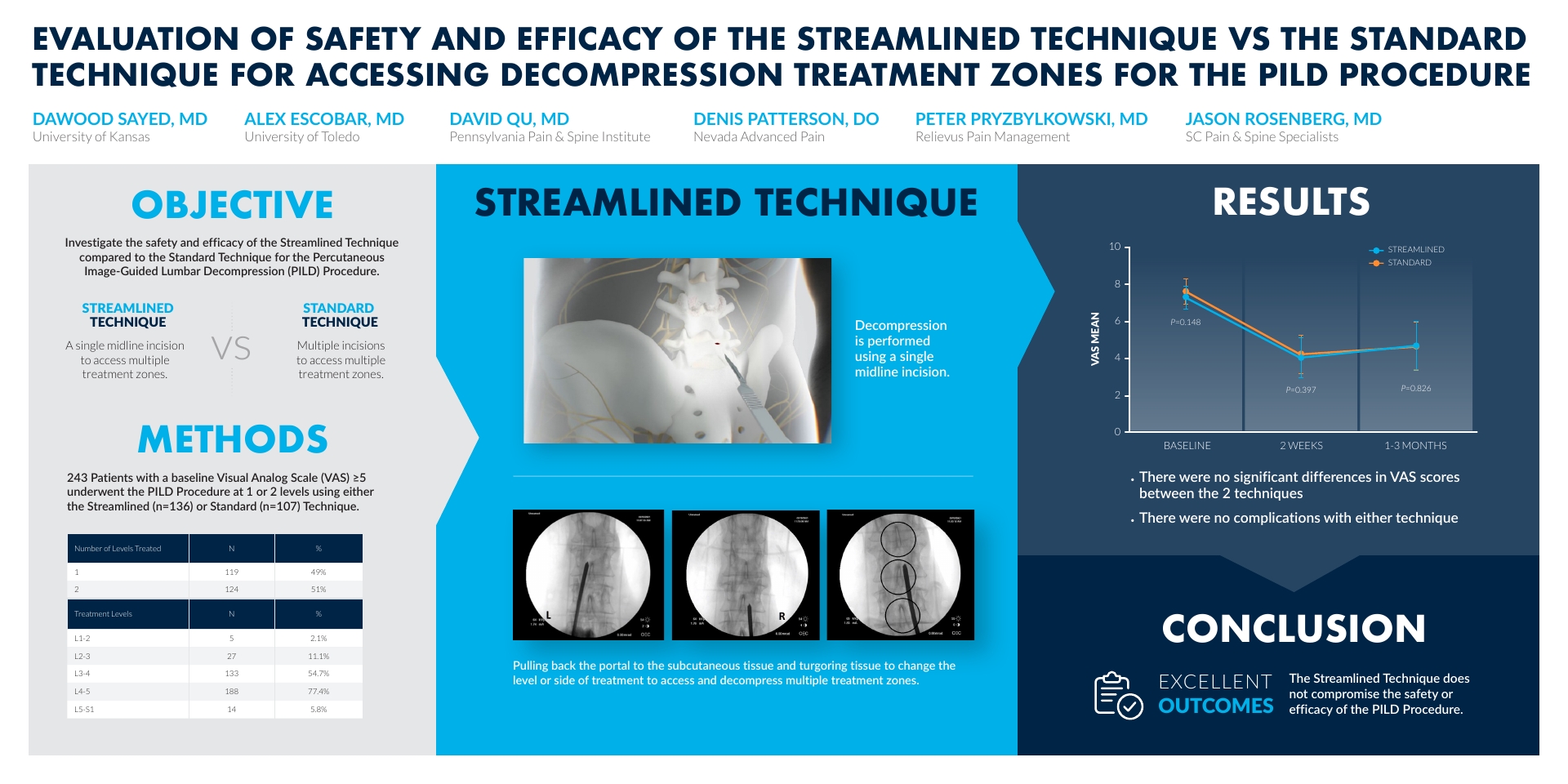
Watch Dr. Dawood Sayed present his abstract from the American Society of Pain and Neuroscience’s (ASPN) Third Annual Conference, where he discusses how the study found that adopting the Streamlined Technique allowed for efficient and effective decompression of multiple treatment zones, without compromising the safety or efficacy of the mild® Procedure.
Eager to further understand the mild® Procedure and the technique described above? Contact Vertos Medical to learn more about the Streamlined Technique or check out the animation and physician experience from Dr. Navdeep Jassal in this Procedure Evolution blog.
Dawood Sayed, MD (00:00)
Hello, I’m Dr. Dawood Sayed and I’m a Professor of Anesthesiology and Pain Medicine at the University of Kansas. Today on behalf of my co-investigators, I’m gonna be presenting our abstract, an “Evaluation of the Safety and Efficacy of the Streamlined Technique vs the Standard Technique for Accessing Decompression Treatment Zones for the Percutaneous Interlaminar Lumbar Decompression (PILD) Procedure.” Our objectives were to investigate the safety and efficacy of the Streamlined Technique compared to the Standard Technique for the percutaneous image guided lumbar decompressive procedure. In summary, the Streamlined Technique is a single midline incision to access multiple treatment zones versus the more traditional standard techniques, in which multiple incisions are made to access multiple treatments zones. It was the hypothesis of the investigators, that using the Streamlined Technique, that we would be able to perform the procedure in an equal satisfactory manner with the same efficacy, but also performing the procedure in a much less invasive manner for the patient.
(01:03) So our methods were 243 patients with a baseline visual analog score of greater than five. These patients underwent the PILD Procedure at 1 or 2 treatment levels using either the Streamlined Technique which is about 136 patients, or the Standard Technique, which was about 107 patients. If you look at the table here, you can see that most of the patients were treated at either the L-3, L-4 or the L-4, L-5 levels. And again, the Streamlined Technique is a decompression performed using a single midline incision. The technique involves pulling back the portal to the subcutaneous tissue, and triggering tissue to change the level or side of treatment, to access and decompress multiple treatment zones through a single incision. When we look at our results, you can see the average pain level was around an 8 on a VAS mean score. When you look at the immediate pain relief and efficacy at around 2 weeks, you can see that the difference between the results and efficacy between the Standard Technique and the Streamlined Technique was almost identical. When you look at these patients a little further out at 1 to 3 months, again, you can see no difference in the outcomes in pain scores, as well as complication rates between the two arms when comparing the Streamlined and Standard Technique. So in conclusion, the Streamlined Technique does not compromise safety or efficacy of the PILD Procedure. We look forward to evaluating this in a more prospective, rigorous manner, to evaluate it as a true change in the way we do this procedure. Thank you.
Benyamin RM, Staats PS, MiDAS ENCORE Investigators. mild® is an effective treatment for lumbar spinal stenosis with neurogenic claudication: MiDAS ENCORE Randomized Controlled Trial. Pain Physician. 2016;19(4):229-242.
Mekhail N, Costandi S, Abraham B, Samuel SW. Functional and patient-reported outcomes in symptomatic lumbar spinal stenosis following percutaneous decompression. Pain Pract. 2012;12(6):417-425. doi:10.1111/j.1533-2500.2012.00565.x.
2012 data from Health Market Sciences report for Vertos Medical 2013.
Data on file with Vertos Medical.
Staats PS, Chafin TB, Golvac S, et al. Long-term safety and efficacy of minimally invasive lumbar decompression procedure for the treatment of lumbar spinal stenosis with neurogenic claudication: 2-year results of MiDAS ENCORE. Reg Anesth Pain Med. 2018;43:789-794. doi:10.1097/AAP.0000000000000868.
Based on mild® Procedure data collected in all clinical studies. Major complications are defined as dural tear and blood loss requiring transfusion.
MiDAS ENCORE responder data. On file with Vertos Medical.
Jain S, Deer TR, Sayed D, et al. Minimally invasive lumbar decompression: a review of indications, techniques, efficacy and safety. Pain Manag. 2020;10(5). https://doi.org/10.2217/pmt-2020-0037. Accessed June 1, 2020.
Deer TR, Grider JS, Pope JE, et al. The MIST Guidelines: the Lumbar Spinal Stenosis Consensus Group guidelines for minimally invasive spine treatment. Pain Pract. 2019;19(3)250-274. doi:10.1111/papr.12744.
Hansson T, Suzuki N, Hebelka H, Gaulitz A. The narrowing of the lumbar spinal canal during loaded MRI: the effects of the disc and ligamentum flavum. Eur Spine J. 2009;18(5):679-686. doi:10.1007/s00586-009-0919-7.
Treatment options shown are commonly offered once conservative therapies (e.g., physical therapy, pain medications, chiropractic) are not providing adequate relief. This is not intended to be a complete list of all treatments available. Doctors typically recommend treatments based on their safety profile, typically prioritizing low risk/less aggressive procedures before higher risk/more aggressive procedures, but will determine which treatments are appropriate for their patients.
The mild® Procedure is a minimally invasive treatment for lumbar spinal stenosis. As with most surgical procedures, serious adverse events, some of which can be fatal, can occur, including heart attack, cardiac arrest (heart stops beating), stroke, and embolism (blood or fat that migrates to the lungs or heart). Other risks include infection and bleeding, spinal cord and nerve injury that can, in rare instances, cause paralysis. This procedure is not for everyone. Physicians should discuss potential risks with patients. For complete information regarding indications for use, warnings, precautions, and methods of use, please reference the devices’ Instructions for Use.
Patient stories on this website reflect the results experienced by individuals who have undergone the mild® Procedure. Patients are not compensated for their testimonial. The mild® Procedure is intended to treat lumbar spinal stenosis (LSS) caused by ligamentum flavum hypertrophy. Although patients may experience relief from the procedure, individual results may vary. Individuals may have symptoms persist or evolve or other conditions that require ongoing medication or additional treatments. Please consult with your doctor to determine if this procedure is right for you.
Reimbursement, especially coding, is dynamic and changes every year. Laws and regulations involving reimbursement are also complex and change frequently. Providers are responsible for determining medical necessity and reporting the codes that accurately describe the work that is done and the products and procedures that are furnished to patients. For this reason, Vertos Medical strongly recommends that you consult with your payers, your specialty society, or the AMA CPT regarding coding, coverage and payment.
Vertos Medical cannot guarantee coding, coverage, or payment for products or procedures. View our Billing Guide.
Vertos is an equal employment opportunity workplace committed to pursuing and hiring a diverse workforce. We strive to grow our team with highly skilled people who share our culture and values. All qualified applicants will receive consideration for employment without regard to sex, age, color, race, religion, marital status, national origin, ancestry, sexual orientation, gender identity, physical & mental disability, medical condition, genetic information, veteran status, or any other basis protected by federal, state or local law.
Hall S, Bartleson JD, Onofrio BM, Baker HL Jr, Okazaki H, O’Duffy JD. Lumbar spinal stenosis. Clinical features, diagnostic procedures, and results of surgical treatment in 68 patients. Ann Intern Med. 1985;103(2):271-275. doi:10.7326/0003-4819-103-2-271.
Kalichman L, Cole R, Kim DH, et al. Spinal stenosis prevalence & association with symptoms: The Framingham Study. Spine J. 2009;9(7):545-550. doi:10.1016/j.spinee.2009.03.005.
Fukusaki M, Kobayashi I, Hara T, Sumikawa K. Symptoms of spinal stenosis do not improve after epidural steroid injection. Clin J Pain. 1998;14(2):148-151. doi:10.1097/00002508-199806000-00010.
Mekhail N, Costandi S, Nageeb G, Ekladios C, Saied O. The durability of minimally invasive lumbar decompression procedure in patients with symptomatic lumbar spinal stenosis: Long-term follow-up [published online ahead of print, 2021 May 4]. Pain Pract. 2021;10.1111/papr.13020. doi:10.1111/papr.13020
Friedly JL, Comstock BA, Turner JA, et al. Long-Term Effects of Repeated Injections of Local Anesthetic With or Without Corticosteroid for Lumbar Spinal Stenosis: A Randomized Trial. Arch Phys Med Rehabil. 2017;98(8):1499-1507.e2. doi:10.1016/j.apmr.2017.02.029
Pope J, Deer TR, Falowski SM. A retrospective, single-center, quantitative analysis of adverse events in patients undergoing spinal stenosis with neurogenic claudication using a novel percutaneous direct lumbar decompression strategy. J Pain Res. 2021;14:1909-1913. doi: 10.2147/JPR.S304997
Pryzbylkowski P, Bux A, Chandwani K, et al. Minimally invasive direct decompression for lumbar spinal stenosis: impact of multiple prior epidural steroid injections [published online ahead of print, 2021 Aug 4]. Pain Manag. 2021;10.2217/pmt-2021-0056. doi:10.2217/pmt-2021-0056
Abstract presented at: American Society of Pain and Neuroscience Annual Conference; July 22-25, 2021; Miami Beach, FL.
Mobility Matters: Low Back Pain in America, Harris Poll Survey, 2022. View data and full summary here.
Deer TR, Grider JS, Pope JE, et al. Best Practices for Minimally Invasive Lumbar Spinal Stenosis Treatment 2.0 (MIST): Consensus Guidance from the American Society of Pain and Neuroscience (ASPN). J Pain Res. 2022;15:1325-1354. Published 2022 May 5. doi:10.2147/JPR.S355285.
Connect with us: Stay up-to-date with the latest information on the mild® Procedure and tag us in your posts!
Social Media Templates
Incorporate these ready-to-use social media templates into your feed. Include hashtags: #mildprocedure #vertosmedical #lookfortheligament #MOVE2mild #lumbarspinalstenosis #lss.
Now Offering mild®
We are excited to announce that we offer the minimally invasive mild® Procedure for patients with lumbar spinal stenosis (LSS). This short, outpatient treatment removes a major root cause of lumbar spinal stenosis through an incision smaller than the size of a baby aspirin and has shown to significantly improve LSS pain and mobility.
Get in touch with [PRACTICE] to see if you may be a candidate for the mild® Procedure at [PHONE #] or [WEBSITE].
Symptoms of LSS
Pain, numbness, heaviness, and tingling in the lower back, legs, or buttocks when standing or walking are common symptoms of lumbar spinal stenosis (LSS) that can make doing everyday tasks unbearable. The minimally invasive mild® Procedure addresses a major root cause of stenosis, by restoring space in the spinal canal to help improve back and leg pain.
Find out if you may benefit from the mild® Procedure by contacting [PRACTICE] at [PHONE #] or [WEBSITE] today.
Injections Stopped Working?
If you’re among the millions of patients searching for answers about chronic low back pain (CLBP) or if epidural steroid injections (ESIs) have stopped working, [OUR OFFICE] may be able to help.
Make an appointment today to learn more about our available treatments for CLBP, including the Mild Procedure for lumbar spinal stenosis (LSS), by contacting [CONTACT INFORMATION] or visiting [WEBSITE].
Stop the Cycle
Make your last epidural steroid injection (ESI) your LAST ESI.
[INSERT OPTIONAL PATIENT QUOTE]
If you are ready to stop the cycle of repeat ESIs for lumbar spinal stenosis (LSS), our office may be able to help. [OUR PRACTICE] is excited to offer the Mild Procedure for lasting relief.
Make an appointment today to learn more about Mild and see if you may be a candidate: [CONTACT INFORMATION/WEBSITE]
Take the First Step
Join the thousands of patients that have conquered chronic low back pain (CLBP) and discovered lasting relief from the symptoms of lumbar spinal stenosis (LSS) by making the #MOVE2mild.
Contact [OUR OFFICE] today and learn how the Mild Procedure may help you regain quality of life. [CONTACT INFORMATION]
If You Have Been Diagnosed With LSS...
If you’re tired of epidural steroid injections (ESIs) providing only temporary relief for chronic low back pain (CLBP) associated with lumbar spinal stenosis (LSS), [OUR PRACTICE] may have a solution.
We’re excited to offer the Mild Procedure, a short, minimally invasive procedure that addresses a major root cause of stenosis, by restoring space in the spinal canal to help improve back and leg pain.
Contact us today to make an appointment and see if Mild may be right for you.
[CONTACT INFORMATION/WEBSITE]
Quote Card
Our recent Mild patient was able to get back to what matters most.
[INSERT PATIENT QUOTE]
If you’re ready to make the #MOVE2mild and get on the path to lasting relief, contact our office today to make an appointment and learn more about the Mild Procedure: [CONTACT INFORMATION/WEBSITE]
Practice to provide a patient image or develop a quote card.
Patient Education Video
A common condition typically found in those over age 50, lumbar spinal stenosis (LSS) contributes to pain and mobility issues and may impact the ability to perform simple tasks. Watch this short patient education video to learn how the minimally invasive mild® Procedure may help those with LSS achieve lasting relief.
Find out if you may benefit from the mild® Procedure by contacting [PRACTICE] at [PHONE #] or [WEBSITE] today.
Click the “Share” button on YouTube to embed the video in your social post.